#the screenshot says 15 minutes ago but by now its been like 2 days. 1 day when i drew this
Explore tagged Tumblr posts
Text




I love draw box
#com. shepart#otto || oc#spent a weird amount of time on this. but yeah. thanks yous#i adored this so much i drew otto reacting to this#the screenshot says 15 minutes ago but by now its been like 2 days. 1 day when i drew this#but im gonna eep before posting cuz its 2 am rn#so im gonna queue this for the day time. hi future ppl 💗#this was queued#and no before you ask. i didnt forget to color them in the first pic. white = negative emotions. they got startled
9 notes
·
View notes
Text
The Notes app
(12/07/2021) (Solar Institute Bulletin No. 2) (From New York City)

Image by T. Wenner
Hello! Thought I’d pop in. Been a cool strange couple weeks since we last spoke. I left New Zealand for the foreseeable future, mooched in LA for a bit, and then headed east. It’s always a pretty wild adjustment back into American life for me, particularly due to the zones I move in — I had true culture shock walking into my (very fancy) hotel room, and actually txted my manager in a panic, like is this too expensive? Are we sure this is ok? Another weird moment of culture shock onset shooting a thing (which I’ll maybe be able to share in next newsletter!) outdoors, everyone was sweating in jean shorts, looking like people, and I was wearing an archive Prada bolero top, hair and makeup pristine. I felt like a freak, you know? Like a fancy little goldfish in her own special bowl. I know you know this, but pop star world is ridiculous and extravagant and excessive and very looks-focused, and I’m reminded of the deep oddness when I’ve been away from it for a while. Anyway. Been going on long walks around the city, which is at its most juicy and delicious and vibrant, going to the studio when I can, starting to talk to journalists and shoot stuff and generally start to become the physical embodiment of my work. Lots of the time, I feel like a brain in a jar, or like this drawing of Ralph Waldo Emerson’s called the transparent eyeball (which I highly recommend you Google, because it’s very much a Solar Power guiding light), but around this time, I’m reminded that I do in fact live in a body that people can see, and it helps communicate and symbolise the work I’ve made. So trying to walk a lot, look at people and things and generally (I hate this phrase every time anyone uses it and I’m inviting you to hate me now) ground myself, and each day that passes sees me become a little more in it, a little less shy about everything and a little more ready to invite you in. Really, I want you to have the whole album tomorrow. But we’ll get to all that.
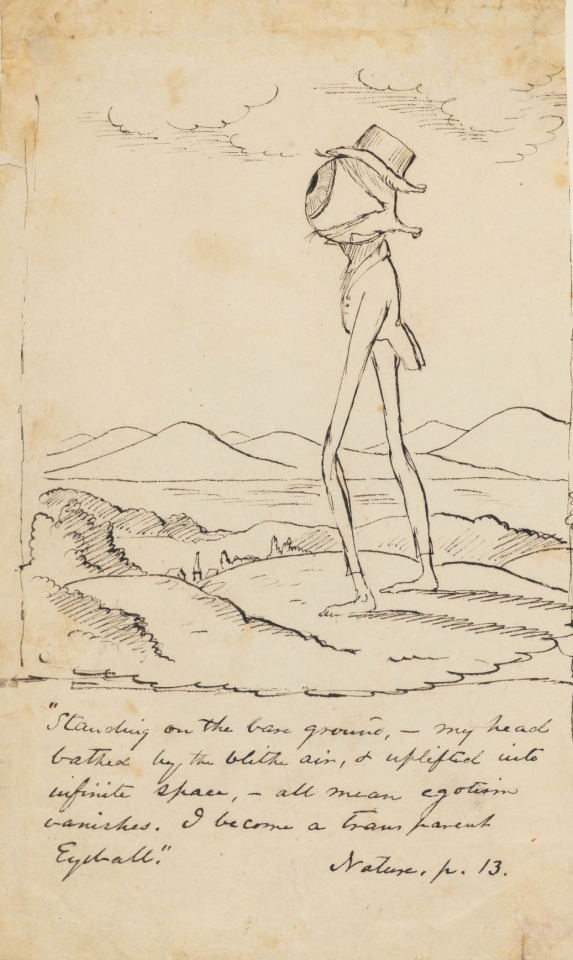
I was up late last night, scrolling through the Notes folder on my iPhone. Notes has become sort of this mythical zone for the modern songwriter, as with Voice Memos, and it’s true — we are all writing every fucking song using these two applications. When i think about any romantic notions I may have had as a kid of writing my songs elegantly in a notebook with pen, I laugh. The truth is, my written hand is really slow. Typing is the fastest I can get something out, and speed is key. But my Notes app also functions as a sort of interesting time capsule— I can see lists of groceries or Christmas gifts I needed to buy years ago alongside deep thoughts about where I’m at and what I’m making as they start to form. I took some screenshots last night, cause I thought it could be of vague interest to you. Starting here, late 2018. Hadn’t started writing anything for this album, but having thoughts about it. And starting to hate being online.
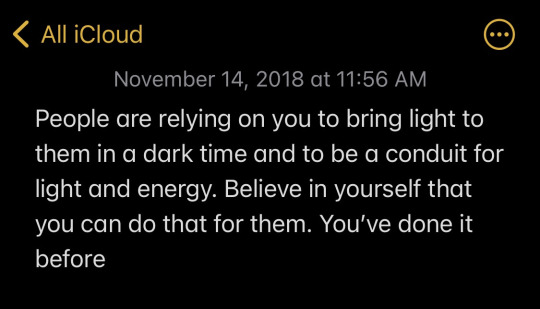
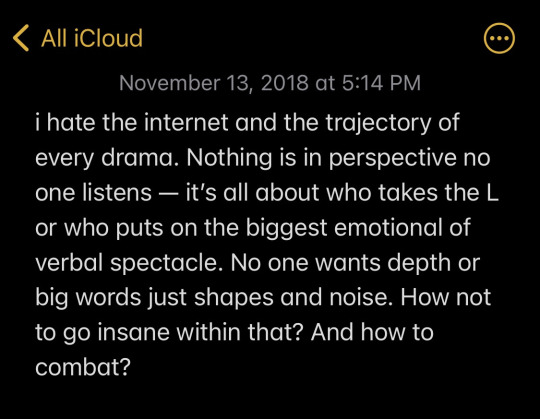
Thinking more about myself as a domestic person, a partner, a mother.

Driving back from Matapouri and going through one of those full roaring tunnels of cicada sound, it striking a deep chord.
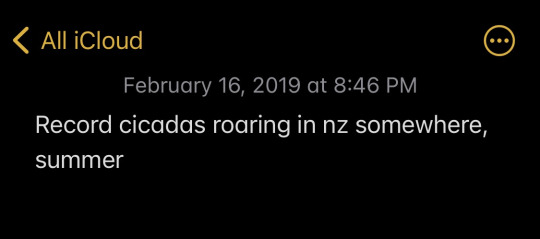
Starting to conceptualise — again, this is before any music has really been written… Maybe I had one song. Check out the March 7th note that’s basically the Solar Power video… before we’d written it.
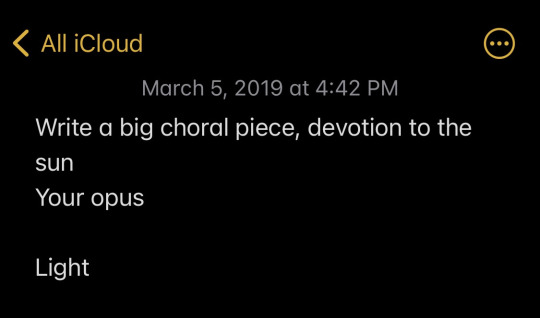
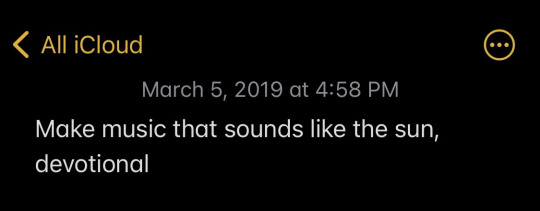
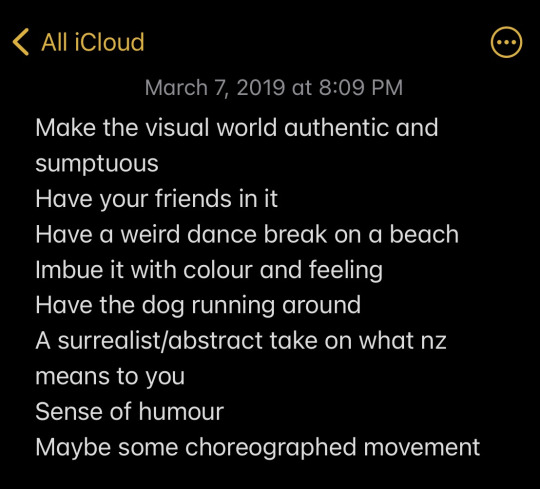
Cute tbh 🌞🥰
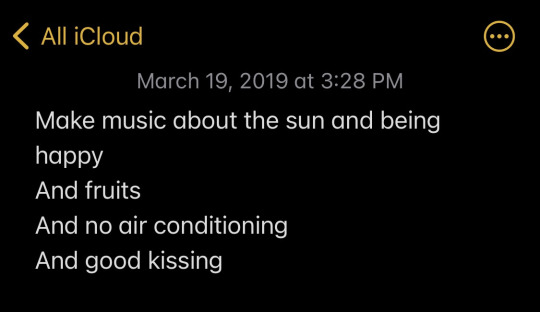
See: 1:15 in SP video...
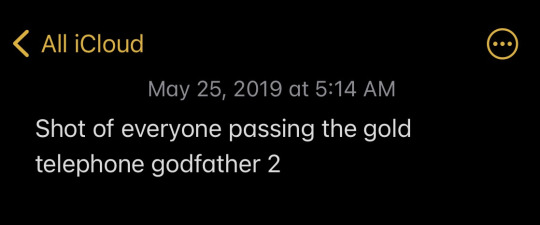
Believe this more deeply than ever!
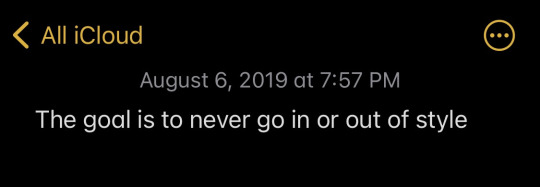
And to finish, a weirdly prescient note, a year before this was all anyone talked about:
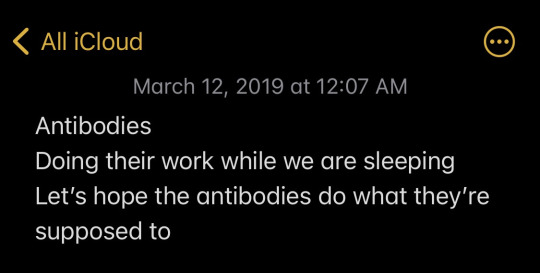
Kinda interesting, no? Hope you’re good, and doing some fun summertime shit if you can. Oh, I forgot to say, I was here for 4th of July, my first ever. We rode around Amagansett on bikes at dusk, parked up at the beach and stood on the sand for a few minutes. I had eaten a gummy. The light was gold and misted. Wealthy people were sunning themselves. It was distinctly surreal and beautiful, with something simmering underneath — America. Speak soon, E x

Image by T. Wenner
(source: received this email)
11 notes
·
View notes
Text
Bothersome Beams in Sirena’s Sickbay
You know how I’ve drawn a clean layout of the Captain’s Quarters to make it reflect the room as seen on screen by e.g. erasing the false door, adding in furniture and marks for the windows, etc? I've been doing that for a bunch of other places as well (toooootally not because I’m procrastinating the two Deep Dives I should be working on....), and a few days ago I started on sickbay. And now I'm stuck.
I've been staring at this so long my brain is turning to mush, so now you all get to suffer with me!
(Fair warning: there be loads of extremely pedantic observations ahead. I hope you like staring at deck plans :D)

This is the outline of sickbay on the deck plans from the blu-ray Set Me Up featurette:

(For orientation and because it will become important later: The front of the ship is on the right-hand side, the back is on the left.)
A quick reminder of the relevant main features: the round part of sickbay has walls that slope outward towards the top, a counter running along the wall around 2/5 of the way up, and three support beams cutting through the wall and the counter.
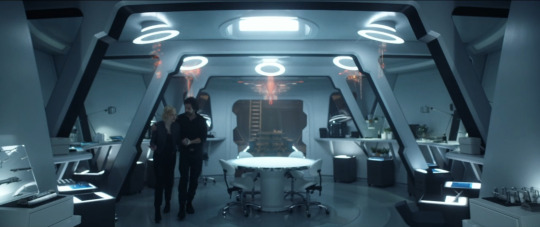
(Note that in reality, the beams are all straight across the top; they just appear curved here due to lense distortion.)
Looking at the concentric circles in the outline above, let’s try to figure out what’s what. Easiest: the broken grey lines, i.e. the largest two circles, surely must be where the wall meets the ceiling at its widest extension. (Here marked in blue.)

Next, when we look at the transition between the rectangular alcove at the back of the room (marked “med bay” in the plan) and the round “lab area”, we see that it’s smooth and there is no step in between.

(Again: the walls are straight, not curved, it looks that way because of lense effects.)
Given that and the thickness of the line, I think it’s safe to assume this is the outline of the wall, most likely at floor level:

These, as far as I can tell, are the windows at the front of the room, next to the door.

As you can see, they extend almost to the top of the wall and stop short of the unidentified outer circle. Looking at a screenshot...
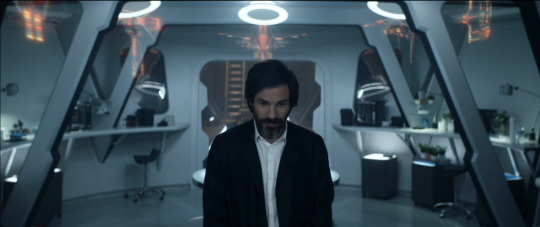
...the windows sit right above the counter, so it makes sense that the remaining lines would be the outline of said counter (here in green):

So far so good.
Here’s the rub. I was trying to figure out what the vertical lines dividing the counter next to the support beams might be, when I noticed these four bits:

Those look like the places where the support beams cut through the counter.

That makes sense, right?
As you’ve probably noticed before, these beams run throughout the entire ship. We see them everywhere on the upper and lower deck, they are clearly the skeleton that holds Sirena together. You can tell how important they are to the structural integrity because all the deck plans have these vertical, broken grey lines to indicate where the beams are located.
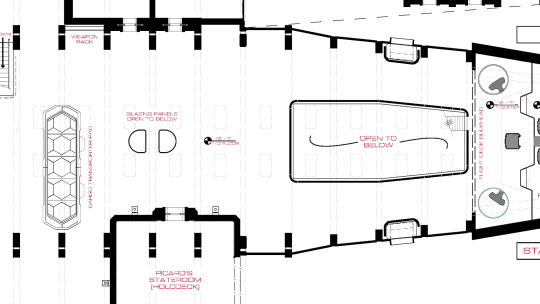

Now, take another look at the markings where the beam towards the back of the room cuts through the counter (I magnified the one on the bottom left):

As you can see pretty clearly, the marking in the counter doesn’t line up with the normal position of the beams, indicated by the broken grey lines. It isn’t off by much. My rough estimate so far is that the beams are about a foot wide with seven feet between them, so this is a difference of maybe 15cm (~6″, apparently). But something is clearly strange here.
You can tell there’s something different at the back of the room, because where the beams in the middle and front are marked by long rectangles, the one in the back is only a small square. It looks almost as if there was only a single column on either side. If that was the case, it would probably mean that the beam at the back of the room was a fake, not technically connected to the beams at the rest of the ship like the middle and front ones.
But does that mean it was also moved a few centimetres further to the front? This has been driving me nuts.
There are a few possible explanations for what might be happening here.
1. I am wrong about those being the markers for where the beams cut through the counter. That is entirely possible.
2. Some changes were made to the set that aren’t yet reflected in this version of the layout. As I said elsewhere, these plans aren’t quite accurate to the final set in all details (e.g. the two steps between the mess hall and sickbay aren’t marked), so it’s possible that this is some intermediate version where the counter design varies a little from its final configuration.
3. The support beams at the back of sickbay do not line up with the beams in the rest of the ship. The production designers decided that they wanted sickbay to be the exact size we see in the plans, but for some logistical or aesthetic reason, having the beams at the back of the room in the logical position (i.e. parallel to the ones on the upper deck) didn’t work, so they moved them forward a little bit.
I cannot tell you how long I spent over the weekend trying to make heads or tails of this.
At first I thought: Well, obviously the beams must have been moved to the front. The grey line marking where they should be goes right across the front of the rectangular bit of the room. They’d block the way if they were in the “correct” place, right?

Except I realized my spatial reasoning is woefully inadequate when trying to visualize a round room with sloped walls, so I did the only reasonable thing: I taught myself how to use SketchUp (again) to make a very, very crude 3D sketch of the relevant sections of this room.

Turns out: when you put the beam exactly where it’s supposed to go, it does actually work out okay. I know it’s a little too small here compared to what it should be...

...but that’s probably more due to my estimates for the thickness of the beams and especially the height of the room being off.
I did another version where I moved the beam forward so it sits where the counter is marked on the deck plan, and the difference is pretty negligible:

It looks a little closer to what we see on screen, but again, that’s probably more a miscalculation issue than an honest-to-god result.
As a last-ditch effort I had another look through my screenshot collection. My thinking was that if the beam was moved forward slightly from where it was “supposed” to be, that would mean we’d see more of it.

(On the left, the beam lines up with the grey lines. The area where it intersects with the counter (solid red) is smaller than in the right-hand example, where the beam was moved to align with the marking in the counter.)
Likewise, the distance the beams extend under the counter would be different, if not by much.
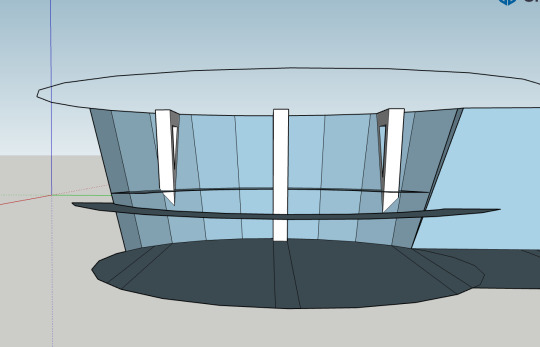
(The beam on the right is moved slightly towards the middle of the room. You can see that it dips lower than the beam on the left, which is in the “correct” position.)
If this was the case we should be able to see it in the screenshots, right? Except...
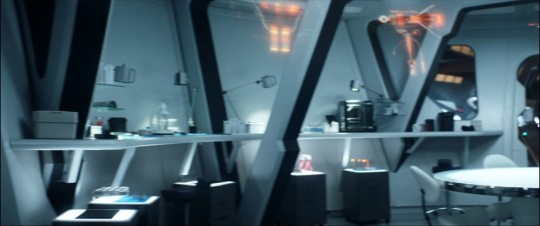
This is the view towards the front of the room. It’s difficult to tell with the perspective, but I don’t think there is much of a difference in how far the beam towards the front of the room (far right) and the one at the back of the room (far left) extend below the counter?

Maaayyybe there’s a difference there? But then again, if you compare how far they dip below the tops of the chests of drawers, that seems pretty similar...
And this is the point where I decided this insanity had gone on long enough and I should probably stop before my brain got entirely scrambled (since, sadly, I don’t have an EMH to unscramble it for me).
So, what’s the takeaway here?
1.: Short of somebody from the production team giving confirmation either way, we won’t know what happened here. I might have misread the set plan, the plan might have changed, or the beams might have been moved. It will have to remain a mystery until we get more shots with incontrovertible evidence, or somebody takes a measuring tape to the set and reports back ;9
2.: For the purposes of drawing a layout of sickbay, I’m going to assume the beams are in the correct position, since that makes more sense in-universe. I’ll move the counter markings accordingly. If I have to make a correction to that at some point, at least I have done the legwork and can refer back to this post instead of having to explain the whole issue again.
3.: Yes, I did just spend half the weekend obsessing over 15 centimetres, to the point where I taught myself SketchUp (again) and wrote a way too long blog post (I did warn you ;9 ), only to come to the conclusion that, as we say over here: “Nichts Genaues weiß man nicht.” - I guess we’ll never know. I have absolutely no regrets!
And finally 4.: staring at images of sickbay for hours on end really makes you appreciate just how beautiful that space is. Scroll up again and have a look at the screenshots. The way the circle repeats in the lights and the table and the concentric markings on the floor. The intricate holograms projected by the ceiling lights. The plants and tools all along the counters that give the room so much texture and make it seem like a real, lived-in place. The way the crisp black and white paint on the beams and the gleaming floor contrast with the cared-for but scuffed up plating and worn-off red paint all over the rest of Sirena... I just really love this ship, okay?
Anyway. If you have any thoughts on this, or you’ve noticed something I missed, I’d love to hear about it!
I was about to say “I promise the next post will be shorter”, but who are we kidding? My brain doesn’t do brief. And what is this blog for if not extremely rambly analyses that give us all an excuse to ogle screenshots of La Sirena for a few minutes?
#star trek picard#la sirena#lower deck#sickbay#deck plans#layout#inconsistencies#long post#progress blogging#does it still count as 'progress blogging' if there was no actual progress? 😅#let's maybe emend that to#minimapping#i really hope this was understandable and i didn't butcher too many technical terms#who gave the non-native-speaker with the very shaky grasp of interior design and architectural terms the keys to the mapping blog?#at this point the word 'beam' has lost all meaning to me...#but any weekend that involves staring at pictures of Sirena for hours and yelling observations at my friends is a good weekend!
9 notes
·
View notes
Text
explorers of arvus: 8.27.18
anyway i forgot what we did. was last session us doing the dead grove? oh yeah i think we like, did a pit stop in welna after SAVING THE WORLD.
basically taure got in a fight w/ the campaign antag, sieron got reaffirmed as the protagonist, charlie blew shit up, and then chego transmuted soup x100
hhjgsdkj got derailed before the session even started bc solar has screenshots of summer saying "KJ! HAS! FUCKED!"
they also have a screenshot of summer saying "it's for the greater good! of me. its for the greater me" but sier display name is KJ Fucks and i really hope its still not that when i do the rabbit tomorrow
im actually gonna take a moment to read the last d&d thread hgxdfkhgfdlkgdlfk
1) oh wow no wonder i couldnt remember, its been a month 2) there's a tweet that says "I SENT THE CALL STRAIGHT TO HELL" AND I WISH I COULD REMEMBER WHAT THE FUCK I DID
[everyone starts going "hewwo?"]
michael: so you know how the oracle shit happened a year ago? hex: WHAT (solar: i wasnt there! :D hex: YOU SURE WERENT, IT WAS A YEAR AGO) michael: yeah its been only 15 days ingame
solar: ill horf snarf my ramen as quickly as possible-- hex: dont die! solar: DONT DIE?! hex: dont die! solar: i wont! hex: guess aile'll die!
charlie has known most of the party for an in-game month and she is fucking ride or ride. RIDE OR DIE
[walks back in to call] michael: ...the average human has probably not fucked paraphrased bc im LOSING MY MIND
i linked this thread to gill bc michael isnt letting her spectate the session again and i could hear her muffledly giggling
hex: sieron has balls [immediately regrets saying it] solar: sieron has big dick energy jorb: [SOUNDS LIKE HE JUST DIED]
penn: im pawty tweasuwew~! hex: you are! you're fucking kawaii!
hex: im 3 feet tall and weigh as much as a toaster! michael: did you just say you're TWENTY feet tall?! hex: NO!!!!!!!!
michael: behold the bizarrity of a hexagonal world! penn: thanks i hate it hex "hexagon aesthetic" hexagonest: [cracking up quietly]
penn: we're going to tevarin! who's driving? it's me-- SHIT michael: "we're going to tevarin! who's driving?" taure says, from the driver's seat
charlie: thorne! name your fucking horse! thorne: [sounding afraid and british] i- i dont know how to ride a horse!
i love hearing gill and michael arguing in the bg
[charlie dabs for no reason]
thorne is having a Good Time
thorne lived in the feywild for like their entire goddamn life so they are having a good-ass time being in a material plane also solar rolled a nat20 perception
we're riding back to artevon so we passed the ettin from the Ettin Fight so i got to fill solar in on what happened and taure got to roll deception to pretend she's not upset :,)
i think gill is Constantly sassing michael the entire time and i can only hear bits and pieces but omg
michael: [explaining] thorne is from the emerald dream. solar: thorne is from bullshit land, where everything is bullshit hex: so, the emerald dream penn: i think EVERYONE is from bullshit land
charlie rolls athletics to hold her giant fucking dog
justin is big enough for charlie to RIDE but thats bc charlie is 3 feet tall
oh my god i forgot tevarin is where taure did the magic weed thing. we're in tevarin rn
charlie is banned from All Libraries
thorne: i really dont mind either way. [silence] charlie: swag.
thorne: who... IS the oracle, exactly? taure: hes a cool dude. charlie: he stuck me and sieron in a horrible teleporting loop.
time to bother the oracle again!
[everyone discovers the oracle shop is abandoned] taure: ... [leans down to charlie] can you pick the lock? charlie: "can i pick the lock", she asks. >:D
GRYPHON!! RETURN OF BABY GRYPHON!!!!!!
we forgot their name so now theyre Bimble
gryphons are Monstrosities
i think we stole bimble
charlie, very casually to a shopkeep: taure got some weed once.
penn: is there anywhere i can get a book on gryphons? hex: is there a library here? penn: oh no hex: CHARLIE'S NOT GOING IN THERE
penn: open up a nice cold.. glass of bepis
taure: i dont get this magic mumbo jumbo. charlie: me neither, and i FART magic! ..thats what wild magic surges are, i just fuckin fart magic
[thorne clips into Mystery Magic Orb]
michael: thorne closes his eyes, and hears a very quiet... pppbbbbbbt.... as bimble farts. hex: [KEELS OVER IRL LAUGHING] penn: bottle that shit, we can sell it on ebay! I DONT MAKE JOKES. I DONT MAKE JOKES. I DONT MAKE JOKES
the party spends like 10 minutes bothering an Invisible Orb
jorb: are you saying that orcs just naturally have a british accent?!
i dont care what michael says, orcs are british now
michael: [...] some lovely fowl, some steaming potatoes... hex: screaming!? michael: STEAMING, the potatoes do not scream solar & penn: [SCREAM]
michael: plot twist: you take bimble across and the horses eat kaepora.
penn: friendly reminder: taure would die for charlie hex: charlie would die for her too. michael: they will. penn: yaaaAAAAaayyy
[discussing if sieron is swole] michael: the real question is... is sieron thicc. [everyone has a fear response] michael: do he got the booty? [michael is forcibly removed from call]
[michael and penn arguing over michigan being shaped like a hand]
"i presto the SHIT out of everything."
"i presto the SHIT out of taure"
penn: that or, you could just tell me hex: NO
taure: did i get it? solar: ...did she get it? michael: did you get it?
taure got some blood on her face (bimble decided to be Extremely Cat with gift of dead mouse) and Comedy Ensues
"i think taure IS a serial killer"
[everyone discussing what to do about an ambush] charlie: [sticks head out of wagon grinning] i enjoy killing people! [rolls a 22 on intimidation] THE ENTIRE ENCOUNTER: [SCARED SHITLESS] [LEAVES]
reminder: charlie is 3 feet tall, very adorable, and EXTREMELY DANGEROUS
jorb: we killed their hopes. hex: that's why we're the Hope's Guard! --wait michael: you killed their clean underwear. jorb: UNDERWEAR: SLAIN
we're all trying to explain Big Dick Energy to gill
big michael energy
#[clever queue tag]#leo chirps#txt#there are SO MANY CALLBACKS#pretty much all of them to the first liveblog post i did wtf#also ''you take bimble across and the horses eat kaepora'' is SO GOOD and is the other thing i quote internally all the time#we kept worrying that bibble and kaepora would try to eat each other.
3 notes
·
View notes
Photo
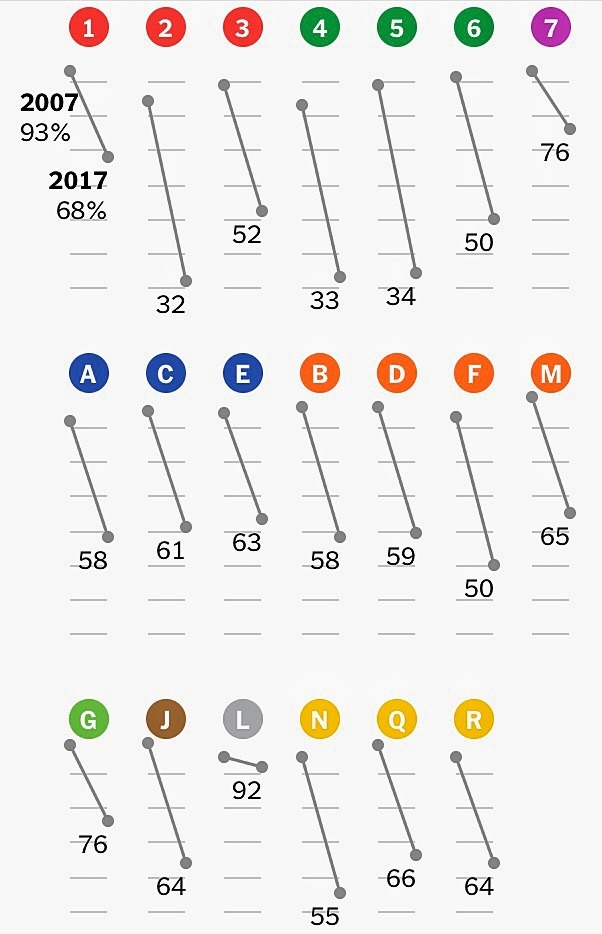
Absurd New York #83: Bad Subways Edition
As a flurry of investigative reports in the New York Times depicted this week, we haven’t been imagining it at all: our transit system has been unraveling for a decade now. Take the graphic above, for instance. In 2007, according to the Metropolitan Transit Authority’s (MTA) own data, trains ran “on time” over 90% of the time on weekdays. Today, they’re only 65% likely to operate on schedule. What’s even more extraordinary is that some lines don’t even appear to be trying anymore. (I’m looking at you, Number 2!)
For MTA statisticians, a train is “on time” if it arrives at its final destination no more than five minutes behind schedule and doesn’t skip a stop. So, for example, if an N Train leaving Ditmars Blvd-Astoria arrived at Stillwell Avenue-Coney Island three minutes behind, it’s considered “on time.” If it by-passed 14th Street-Union Square, however, it’s marked “late” since it didn’t run its entire route. Too bad there’s no data on the average amount of time a train is late when it comes in as such. Suffice it to say, the results would probably be less than admirable.
To make matters worse, when compared with others around the world, our transit system ranks 21st in on-time performance so far this year. Which ones are better? Well, the ones in Mexico City (71%), San Francisco (86%), Washington D.C. (88%), Madrid (91%), Miami (92%), Baltimore (95%), Chicago (96%), Vancouver (96%), Toronto (96%), Atlanta (97%), and Boston (97%). The remainder--those in Montreal, Philadelphia, Paris, Berlin, Seoul, Los Angeles, Singapore, Taipei, and Hong Kong--have efficiencies over 98%!
“We Apologize for Any Inconvenience.”
So what gives? Well, as the Times uncovered, what’s happening today is the direct result of “a perennial lack of investment in tracks, trains, and signals.” It’s as simple as that. Despite an increase of 77% in ridership between 1991 and 2015 (from 1 billion to 1.8 billion annual riders), the system has suffered a loss of total track mileage (dropping from 493 to 488 miles) and added only 27 new cars to the fleet (from 5,255 to 5,282 cars) during that span.
Moreover, the State Legislature has kept the MTA’s budget for maintenance and at about the same appropriation since 1991. The consequence? Today, “more than 2,000 jobs in critical areas like repairing signals, tracks, and cars [are] unfilled” because there’s not enough money to pay mechanics. That understaffing has wrought signal problems and has led to subway cars breaking down “twice as frequently as a decade ago.” In 2005, for instance, the average car could travel about 178,000 before having one of its components fail. In 2016, the same car could manage only 112,000 miles.
“Soliciting Money in the Subway Is Illegal. We Ask You Not to Give.”
So where’d all the money for maintenance go? Well, as the Times suggested, it’s been spent largely on cosmetic improvements to the system instead. There are several egregious cases. Take the MTA burning through $1.4 billion to erect the new Fulton Street station, $135 million to refurbish the Bleecker Street station, $66 million to restore the Cortlandt Street station, or nearly $1 billion to support Governor Andrew Cuomo’s 2016 “Enhanced Station Initiative”--the one that added “lighting, signs, countdown clocks, and other upgrades to dozens of stations.” Furthermore, Cuomo even persuaded the MTA to spend “tens of millions of dollars to study outfitting [its] bridges with lights capable of choreographed display, install wireless internet and phone-charging ports on buses, and paint the state logo on new subway cars.” Pretty toppings for sure, but none of them improved the system’s on-time reliability.
Additionally, for some unknown reason, the MTA decided to use its resources to bail out other businesses over the years. Most notably, it endowed Belleayre Ski Center, Gore Mountain, and Whiteface Mountain--all state-run ski resorts--with $5 million in March 2016 after each experienced bad winter seasons. It even gifted another $5 million to the Triborough Bridge and Tunnel Authority in 2013 to help that entity cover a deficit it incurred for reducing tolls way back in 2000.
“We’re Being Momentarily Held by the Train’s Dispatcher.”
Since 1968, the city and state have had a vested interest in the subway--the city owns it, the state operates it--so both mayors and governors alike have had a hand in directing its finances. The MTA’s capital handicaps, however, began in the 1990s. According to the Times, when Governor George Pataki (1995-2006) revoked its state subsidies and capital funding for projects, he forced the MTA to depend solely on fares, tolls, and revenue from taxes for its survival. Moreover, when Pataki’s state income tax cut was approved in 1995, he paid for it with $200 million in tax revenue that had been originally earmarked for the MTA. Since then, he and his successors have divested the MTA of “at least $850 million” of its own money. Presumably, some of that could have been used to repair tracks, trains, and signals around the city.
On the other hand, Mayor Rudy Giuliani (1994-2001) decided to break from a precedent too. Instead of continuing to fund 10% of the MTA’s total budget like other mayors before him, Giuliani reduced the city’s contribution by $400 million. Later on, although Mayor Michael Bloomberg (2002-2013) used city funds to help finance bonds for the extension of the 7 Line to 34th Street-Hudson Yards, he kept the city’s supplement for the MTA at Giuliani levels. Their moves had an astonishing effect. Whereas the Dinkins Administration (1990-1993) gave about $1 billion in today’s money to the MTA back in 1990, Mayor Bill de Blasio set aside just $250 million for the MTA this year.
Because of all this disinvestment, the MTA has resorted to printing bonds to pay for things like new construction. Over the past six years, the Times tallied that the MTA has issued “about $15 billion” worth of bonds, a total that now comprises 52% of its overall capital funding. But it’s the interest on those bonds that really hamstrings the agency’s finances. “Every second of the day,” the Times declared, “the MTA pays $83 in interest. That’s $7.1 million in 24 hours...$2.603 billion” for the year. So much for buying a new car or two for the N/W Line.
“This Is the Last Stop on the Train. Everyone Please Leave the Train.”
In 2017, New York City is more populated and even vastly more affluent than it was in 1991. Arguably, its revenue from property taxes alone could fund city after city all over America. With this year’s fiscal year budget hovering around $88.4 billion, how can it possibly justify giving less to support the transit system than it did 27 years ago? The same goes for New York State. With a fiscal year budget of $162.3 billion, why does it need to keep shifting revenue away from the MTA? Neither Mayor de Blasio nor Governor Cuomo may be entirely at fault for the subway’s current condition, but they own it now and must be held accountable. Repair the tracks, fix the trains, and replace the signals. It’s absurd if they can continue to find money for everything else but renewing the essential components of a railroad.
-----
(Screenshot taken from The New York Times. Graphic of on-time performance for each of the city’s train lines in 2007 and 2017 compiled by Jasmine C. Lee, November 18, 2017. Retouched by Riff Chorusriff.)
#absurd new york#new york city transit#nyct#nyc subways#bad subways#metropolitan transit authority#mta#new york times#subway performance#governor cuomo#mayor de blasio#andrew cuomo#bill de blasio#tracks trains signals#repair tracks trains signals#subway maintenance#new york city#riffchorusriff photography#riffchorusriff essay
4 notes
·
View notes
Text
a and z tag
tagged by @pastelminhyuks thank u my soulmatecmnbvpoiuytre098765432wedfikjm;l,k\]
-0iuy543qqa1wedczpokjpoiuyt09876tg987654okp;.[’.,mnbvcxzav im laughing i was cleaning my keys so im keeping that
Age: 15 turning 16 soOn
Birthplace: singaporeeeee
Current time: 9pm exact actually i was wrong its 8:58pm my laptop is faster???
Drink you last had: i only drink water so water
Easiest person to talk to: my gemini and scorpio pals
Favorite song: ok real talk.... i gUEss if i had to pick itd be when u love someone by day6 because i even dreamt abt this song so
Grossest memory: more like embarrassing but those r for another day
Hogwarts house: ok story time i went onto mobile tumblr bc jen sent me a link as to where i could find out abt this but i got distracted and then i got distracted again bc someone posted screenshots from fantagio’s website and it looked really pretty so i went to look at it and it is really really pretty holy shit fantagio thank u.. and what the fuck bin is 3 cm shorter than eunwoo i mean like i knew because u can tell but .... wow hes so short... im just kidding but wow.. its been 37 minutes im still on this fucking question og mugod ok its almost 10pm and i got distracted again by astro im finally gonna chec omg im a hufflepuff...GUYS i started smiling so hard omg we’re matching with jen!!!
In love: like right now?? bc no but i am in love with 18 boys and i hope they know theyre all amazing
Jealous of people: nah i used to be really jealous but i dont rly care anymore but its more like im happy for them? sometimes
Killed someone: ya
Love at first sight or should i walk by again: these need to be more detailed whats it asking but ill have u know i would definitely say this shit
Middle name: ?? falen ur middle name is irene/??????? u have a middle name??????? ????? i dont have one but my chinese name is 恩如 (en ru - it means gratitude??? idk)
Number of siblings: one thankfully i cant even communicate with 1 how am i supposed 2 deal with more
One wish: for all of my favourite people to be happy forever
Person you called last: i dont even know i havent been on call with anyone in ages well until tomorrow hehehe
Question you are always asked: idk but three things i will always ask new friends are
how tall r u
whens ur birthday/age
and where are u from (if its an online friend, this applies to online buddies anyway so)
Reason to smile: my favourite people!!!!!!
Song you sang last: no joke but i think it was my school song/hymn i cant remember and that was in late september i dont sing sorry folks
Time you woke up: 8am!!
Underwear color: grey
Vacation destination: im already going 2 japan in like 2 days but id love to go with friends
Worst habit: complaining abt the situation even though i could probably do something about it
X-rays: for my back a year ago maybe
Your favorite food: i eat plain crackers a lot
Zodiac sign: capricocrorooorn
tagging nobody bc i have no mutuals on here i need to make more pals :_) thanks for tagging me falen!! im looking forward to our date yeee the time is now 10:13 pm i spent an hour on this god bless
6 notes
·
View notes
Text
"There’s a Storm in my Head and it’s Killing all the Flowers.”
I've been relatively vocal about having anxiety. I've had a LOT of people message me with support, suggestions, and pure curiosity. I'm always happy to answer what I can... Because though I realize my truth is the same as countless others. I also realize many of them suffer in silence. I think the more I share my struggles, the more others can hopefully understand what their friends, family, and loved ones are going through. I decided to give a brief glimpse of my thought pattern for just a simple trip. I went to Shanghai, which mind you I have been to at least 6 times now. Here ya go...
Tuesday
Okay I really have to get moving on those train tickets for Thursday. I open my computer and search for tickets to Shanghai from Hefei on Aug 31st. My appointment is at 1, so if I leave by 10 that will be fine. No wait, I can't eat breakfast before or my anxiety will make me throw up... I should leave earlier then get lunch there. Yeah, I need to eat I guess. I'll book the 8:00am train which means I have to catch the 7:00 subway and wake up at 6:00.

Okay this train station is closest to where I want to eat. I write down the date, time, and train number. I'll book 3:30pm return. Oh god, what if they're running behind and my appointment goes late, or the line at the subway is long, or I get on the wrong one on accident, and then miss my train? I better make it for 5 just to be safe. Shit, I need to have the concierge order these before the seats are taken... Excuse me while I check 3 different times to be sure he has the correct train info. He's annoyed.
I get the tickets and I immediately check the time, date, and train number.. Phew they're correct. I put them in my purse and go to walk away... Wait! Maybe they're the wrong station, better check them, again. Okay, they're right. Wait, maybe I have the stations confused? It is a big city... I better Google it to be sure. Okay all set, no worries!
Wednesday
11:45pm- I'm falling asleep but I suddenly realize that I NEED to plan out my day so I'm not late for anything. I check the address for Shanghai Station for the 8th time. I get the street address for the place to eat (in Chinese) justttt in case the subway is down or something. Remember I did see an article a month ago where that did happen. It will probably happen again, could be tomorrow. What's the subway station nearest to the restaurant? Hmm I better cross reference that 5 times. Google says that will take 32 mins on the subway, it'll take at least 10-15 minutes to buy tickets, another 5 minutes to walk from the station to the restaurant... Okay so I'll get to the restaurant at 11:04. It's only a half hour cab ride to the doctor from there. But wait, maybeeee traffic will be terrible. I should leave at noon instead of 12:30... just to be safe.
Okay, now I can go back to bed. Wait... Hmm I better look up the address for my doctor in Chinese... Just in case the cab driver can't read the business card font. Maybe I'm being silly? No I'm not, that's happened before. Do it. Okay go to bed. Wait! How am I getting back to the train station? Okay Google says it's a 35 minute cab ride, but it's probably 50 with traffic. That means I should get a cab by 3pm. I'll get there by 4 and the train boards at 4:37, and the security line could be long...

I feel better, now I can sleep. Wait... What if I can't get a cab? I took the subway from there last time. It was like a 13 minute walk, but I can't remember if I had to switch lines. Was the ticket line long there? Shit I can't remember. I better double check the line number and stop for the train station, again.
Seriously it's 2am and I have to get up in 4 hours. I finally begin dozing off, then I think "what's the weather going to be like?" I better check my weather app. It doesn't say it's going to rain, but maybe it will. Oh no I left my umbrella at that restaurant tonight.
Maybe I should've packed my backpack tonight, what if I forget something tomorrow? Okay I need to pack my passport, cash, tissues, sunglasses, glasses (in case I need to take my contacts out), eye drops (ya never know), contact case, coins for the subway, headphones for music, water, my iPad... Am I forgetting anything? Yeah you're forgetting to sleep. Go to bed Jess.
I feel the satin of my eye mask brush my face as I pull it on, and I take a deep breath. Why am I so nervous? My palms are sweating and my heart feels like I just ran the mile for the first time. I literally JUST did this trip 2 weeks ago. I went to the same area for lunch and everything. *1 hour later* I lift up my eye mask, after not sleeping a wink. What time is it? 3:30am. I pull my eye mask back on then immediately tear it off. WHAT. How is it 3:30?? Okay if I fall asleep now I'll get 2.5 hours of sleep. Go to bed.
One hour later I rip off my eye mask in panic... Shit did I set an alarm? I better check its for AM not PM. Okay good, it is. I close my eyes... Shit... Am I sure 6am is early enough? Ugh stop worrying and go to bed. I toss and turn for a bit and finally start to doze off. Great, now I gave to pee.
After the chill of the cold tile woke up my feet, I made my way back to the bedroom and slowly climbed back into bed. Shortly after I doze off, Corey's alarm sounds. That means it's between 5-5:15am think. A second alarm goes off... It's probably 5:30 now. Maybe I can sleep for a half hour.
I hear the shower start and think BUT maybe I should just get up to be sure I have everything around in time?

It's 5:45am and I am scrolling through my phone making sure I have everything screenshot for directions. I make a detailed itinerary down to the minute in my notepad, just to be on the safe side.
6:00am and my alarm blares as I'm holding it in my hands. Great, I feel like I'm going to puke. Why? Why didn't I sleep? I'm hungry. I wish I could eat but I will definitely get sick. Maybe I'm already going to get sick? I need coffee like yesterday. I should wait until I get to the train station otherwise I'll have to pee between here and there and I don't have time for that. But I'm so thirsty. No-don't drink anything or you'll have to go. I glance out the window. Ughhh why did I forget my umbrella yesterday? It's raining.
I begin getting ready and panic hits me. Why do I feel like I can't breathe? I'm literally putting on blush. Nothing is happening. Oh my god I'm having a heart attack. I AM NOT. But maybe I am, that does happen. I Google "symptoms of a heart attack" and "symptoms of a panic attack" ...again, like I don't do this everyday. I should really just bookmark them. Ugh why's this always happen to me?
I do a breathing exercise, that I don't have time for, because if I don't I'm surely going to DIE. My heart has slowed and I can finally breathe normal, but all that anxiety just wrecked my stomach for the day. Yay, that will be great to deal with. I'm out of Imodium which I'm basically taking as a multivitamin at this point.
I glance at my watch, shit! I've got to go or I'll be late! I put my hand on the door handle, and quickly remove it. Now I'm rummaging through my bag to be extra sure I have everything, again. I am meticulous as I rearrange the pockets I have my belongings in. Someone could steal my passport if I'm not careful! That does happen sometimes.
I push the down button outside the elevator 15 times for good measure. What's taking so long? I hear the ding of one arriving, and I get in. I glance at my watch- Yes, I'm on time! The elevator begins to slow and I immediately remember that time a few weeks ago when it briefly stopped working between floors with me and Corey in it. Oh god I'm going to die! Oh never mind, it's just someone on the 10th floor. Oh god I know him. "Good morning Jess!" "Hey, heading to work?" ... That's a stupid question. Why would you ask that? You know the bus leaves at 7, what else would he be doing? He definitely thinks I'm an idiot right now, because I am. "Yes" he replies. Lord, these last 4 floors feel like an eternity. I want to tell him I almost puked on him for a second there, but I just say "have a good day" instead.

It's 6:52am, and I know the subway leaves at 7 on the dot... The subway is right there, but naturally I'm freaking out anyway. I run down the large flight of stairs faster than necessary ... Oh no it's 6:56 what if it leaves early (Realistically I could take the next one and be fine)? I run down the next flight of stairs too. The sign says 4 minutes until the subway car arrives, obviously. I pace back and forth as I skim over my itinerary in my phone, for the 4th time this morning. I feel like a lunatic and now I look like one. I gaze at the map to ensure I know my stop, which is named Hefei South Railway (duh). I count the number of stops 4 times for good measure. I look at my watch. 7:00am, the subway cars are here.
I get on and grab an empty seat without making any eye contact. I slowly pick my head up and everyone is looking at me. Please stop. Maybe they're staring because my music is too loud? I dull it to the minimum and after a few moments I peek again... No they're still staring. I'm very aware of my skin's surface at the moment and it feels like it's crawling with a million tiny legs. A shiver goes up my back and I swallow much too loud for this silent car.
Shit, was that one stop or two? I was too focused on the million legs that I lost count. Ugh I can't see the map from here. Why did I sit here? Maybe I should I get up and look? No. I don't want this lady to think I moved because she sat down; I know my stop's not for 20 minutes. Plus if I stand I'm guaranteed to have to pee. I argue with myself for 10 minutes and begin to panic that maybe I missed the stop.
All the atoms in my body feel like they're about to burst into flames. I kind of wish they would. I can't take it anymore! I'm getting up reading the map! I'm sure the panic is evident on my face as I quickly remove my ass from the bench. Oh, I still have three stops. I better just stand here next to the door; maybe they'll stop staring at me if I squeeze into this corner? Nope. In the door's reflection I can clearly see all of their watchful eyes and heads on a swivel. Why does this subway car feel like it's closing in on me? I can't breathe. Am I going to cry? Because I feel like I'm going to cry. No really I can't breathe right now.

I close my eyes and pray to God to have pity on me and make me invisible to these watchful eyes. I hear the automated baby voice over the intercom talking; my stop is next. The subway arrives at Hefei Station and the I hear the hiss of the doors as they open. No sooner and I'm gasping for air as I catapult myself out of the car at a speed you'd think I was trying to escape death. I mean, it felt like I was. Phew, I did it. I almost hyperventilated for a moment there. Okay, no really...where the fuck's the bathroom in this place?
Step one of 40, but I did it.
So if you don't have anxiety you're probably like WTF is wrong with this chick; seriously who worries like that? Well, I do... And chances are many of your loved ones do too. This is just a glimpse of the hell going on constantly in my brain- just a snippet of ONE topic. My brain rapid fires thoughts like these, on countless subjects, ALL day long. It is exhausting, and frankly getting out of is a miracle most days. Sleep evades me at night, and consumes most of my days. I can't remember what it's like to feel "normal" and not feel this hell. This is just my daily, constant anxiety... not even a bad panic attack. Traveling used to give me the MOST enjoyment. Even though it's harder than hell to get to that destination, I push myself to get there. I have my bad days, weeks, sometimes months... But I will not let anxiety or depression control my life.
If you're out there struggling and feel crazy in your head...just know we are crazy together, and I like to think I'm a fun time.
#anxiety#truth#health#mentalhealth#wellness#story#Thoughts#panic#travel#anxietydisorder#shanghai#Hefei#foreigner#laowai#subway#cab#staring#embarrassed#live#depression#honesty#writing#travel blog#my writing#worry#stress
1 note
·
View note
Text
I recently watched season one of Amazon Prime series The Marvelous Mrs. Maisel, which I found hilarious and thoroughly entertaining. I don’t watch a lot of comedies—I find the writing is better on serious shows that also happen to be funny. However, I found The Marvelous Mrs. Maisel to be the perfect blend of plot and humor. SPOILER WARNING: This review contains spoilers for season one.
As a creative person, I noticed the show, while entertaining, also offered many truths to be learned about pursuing a career in the arts. Now, the show is set in 1958, and there are obviously hundreds of things that are different about pursuing a career in show business, or other creative pursuits, today. Social media. The internet. Society. Stupid people going viral and stealing my spotlight. And not just people. I mean, a rat dragging a piece of pizza down the street can go viral but I can’t get 100 claps on Medium? Anyway….
This show revealed so many epiphanies about pursuing a creative career that are still true today. Here are 4 funny (okay, some are not so funny) epiphanies I learned about the creative life from The Marvelous Mrs. Maisel:
Lesson 1: If at first you succeed, fail, fail again. The main character, Midge, embarks on a career in comedy after her husband, a would-be comedian himself, leaves her for his secretary. She—Midge, not the secretary—gets drunk and goesto the humble nightclub where he performed earlier to collect a pyrex dish she used to bribe the club’s manager for a good time slot. While there, she wanders up on stage and drunkenly explains her very bad evening to the audience, who finds her hilarious. Later, the nightclub’s scheduler, Suzie—one of my favorite supporting characters ever—offers to manage Midge’s comedy career. Midge has a few more good shows, then some not-so-good shows, after which she decides to quit. She later realizes she wants to keep performing.

As a writer, I want to quit pretty much all the time. I’d probably be a lot happier if I did. It occurred to me a few months ago that if I’d known just how much work there is in writing—not just the writing, but the editing, the rewriting—I probably would not have started. I’d have a lot less stress and a lot more time to sit on my ass and watch Amazon Prime, that’s for sure. Hell, I might even have time to vacuum my room twice a year instead of once. But I probably wouldn’t, because I don’t care. Anyway….
But I don’t quit. I keep failing. I try to learn something from my failures. On the show, Midge goes to comedy clubs, watches the most successful comedians, takes diligent notes. Then she tries to apply what she learns to her own writing. She figures out what works for her, what doesn’t, how long to ride the laughs, how to plan her show instead of just rambling and hoping something funny comes out.
This can be applied to other creative pursuits. I read a lot, and have always read a lot, but now I really try to notice how my favorite authors do things. How do they explain back story so seamlessly you don’t even notice, instead of just making a big infodump on page one? How do they explain a fictional world without spending three pages on the scenery? How do they disseminate a large amount of info in snappy dialogue?
When I think I figure it out, I try to do these things myself. It doesn’t always work. I’m still learning, and more importantly, still failing.
Lesson 2: The more privilege you have, the better.
This one sucks, because privilege isn’t usually something you can gain through hard work, and you can’t buy it on Amazon, either. It would be nice if pursuing a creative career was equally easy—or hard—for everyone. But that’s not how the world works. It wasn’t in 1958, and it isn’t today.
In trying to improve her act, Midge finds an ad in an entertainment magazine and hires a guy to help her. She tells him a few things about her act, and he tells her he can write five minutes of material for $15. Now, that’s a pretty cheap rate today, but back in 1958 it would have been pretty expensive.
Can everyone afford to hire a script writer, or an editor, or a cover designer, or whoever they need to help hone their craft? Can we all afford to take acting classes or singing lessons or improv classes? No. Midge lives with her decently well-off parents after her husband leaves and her father-in-law kicks her out. She seems to have some cash left over from the marriage as well, and could probably sell some of their nicer items if need be. She gets a job at the department store so she can buy a television for her room. If she wants to spend fifteen dollars on a script writer (who turns out to be a scammer), she can do so without thinking too hard about it. She can also call her husband and get $200 for bail after being arrested for swearing and flashing her boobs during a show. That shows a tremendous amount of privilege not everyone has. (Money, of course, is only one of many kinds of privilege.)

The one benefit to not having money privilege is that it somewhat protects you from lesson #3….
Lesson 3: Scammers are everywhere.
The best thing to do is ignore them, or be unable to afford them in the first place.
There is no area of show business in which you’ll fail to find grifters promising fame and fortune for a price. Midge meets one when she hires the script writer, who gives everyone the same tired jokes for “$15 for five minutes.” Hollywood is full of acting coaches, voice lessons, etc. who aren’t worth the money. There are, of course, people who are worth the money. Good luck figuring out the difference!
Unless, of course, you have no money to spend on classes in the first place. That’s a surefire way to avoid getting ripped off. It’s also a surefire way to spend all your time working five jobs, leaving you with little time to write, go to auditions, paint, or whatever.
In the publishing world, there used to be a thing called vanity presses, where you paid them to print your book. Today, thanks to the magic of Amazon—aside from Prime, I mean—you no longer need a vanity press to self-publish. Anyone can publish anything on Amazon. Now, some people take the time to learn Photoshop and make their own covers. Some edit and format their own books. These things are time-consuming and not every writer is a cover designer. Not to mention, it’s a really good idea to have at least one other person besides yourself edit your book because it’s hard to do all your own editing.
So there is a genuine need for these services. However, many vanity presses have morphed into “self-publishing services” firms that charge an exorbitant amount of money to edit, design covers, and promote self-published books. Some packages run into the thousands. Again, the way to avoid this nightmare is to either A) do a whole lot of research or B) Just be too broke to pay for any of it anyway.
If you are in the market, read reviews, inspect the company’s website thoroughly, check its ranking, do a search to see what people are saying about it on social media, etc. Also quiz friends who have purchased such services about what they paid to make sure your price is reasonable. In general, avoid spending money if at all possible.
Lesson 4: Trolls Are Everywhere
Every performer gets heckled, but Midge gets a lot of heckling from guys who think women can’t be funny. And say so. It would be nice if we could write this off as a backwards view common in the 1950’s. Sadly, it’s also a backwards view some people still have today in the 21st century. In 2007, there was even a Vanity Fair article in which Christopher Hitchens attempted to mansplain why women aren’t funny. (Apparently, we never evolved this skill because we already appeal to men, and obvs., that’s the only reason for anyone to be funny!)
Midge learns to handle hecklers with aplomb. When an audience member calls her a bitch, she puts her hands on her hips and says, “Who told you?” The audience laughs, and the heckling loser is forgotten. She’s funny, he’s not. It’s a great scene.
Of course today, it’s not just hecklers at shows. There’s the morass of social media, and the evolution of hecklers into what we call “trolls.” (Also known as “hecklers who hide behind computer screens.”) Trolls are happy to attack women, minorities, people who disagree with them politically, and pretty much anyone they don’t like because, I don’t know, it’s Tuesday. As long as you have a big following, of course—for some reason, trolls rarely seem to take offense at people who have, like, 3 followers. Could it be they’re desperate for attention? Or just jealous of anyone who’s even slightly more successful? Anyway…
If you’re going to have a creative career, you’re going to need social media, and if you manage to get a decent following, you’re going to have to deal with the trolls.
I follow a lot of my favorite writers on Twitter, including one who was accused of “ruining science fiction.” Which is pretty bizarre. I mean, it’s one thing not to like an author’s books. I’ve read or tried to read lots of books that just weren’t for me. But the idea that any one author can ruin an entire genre by writing a book you don’t like is pretty fucking ridiculous. (Of course, this particular troll was also upset because the author supports things like diversity in the genre.)
So a few days ago, the writer posted a screenshot about his ruination of an entire fiction genre, with an addendum about how he’s made a lot of money in royalties lately, and “ruining science fiction” is apparently really profitable. It is now my goal in life to ruin science fiction…okay, make it ruinier…and also ruin satire. NOW I know why I’m broke—I haven’t worked hard enough at ruining things!
Of course, if you don’t have the time or desire to personally respond to every troll, there’s another option: Just block and ignore the haters. This advice is easier to give than take. I know I shouldn’t engage with trolls, but, well, sometimes I can’t resist. If you can’t either, at least try to find a clever way to do it, instead of sinking to their level.
One last thing…
So, those are the 4 funny epiphanies I learned from The Marvelous Mrs. Maisel. Before I conclude my review of season one (love it, you should watch it if you haven’t already), I’m going to leave you with some epiphanies I had watching the first two episodes of season 2:
My new favorite quote from any TV show ever: “My goal is money. I don’t have any and I want some.” Suzie, who speaks for me and my goals as well.
Also, I wish my parents would go to Paris, rekindle whatever romantic feelings they must have once had for each other (which I REALLY don’t want to think about), and leave me alone in their house. I’d be so much happier.
Forcing students to take four semesters of a foreign language is just a way greedy colleges make money, because after four semesters of French I still need subtitles when characters speak French. I want a refund from my university.
Now if you’ll excuse me, I’m going to finish watching season 2 and see what other great epiphanies I can find. Hey, the idea for my next novel would be great….
V. R. Craft is the author of Stupid Humans, a thought-provoking science fiction book series that asks the question, “What if all the intelligent humans abandoned Earth—and we’re what’s left?” Her first political satire book, Fail to the Chief, will be released soon.
The Marvelous Mrs. Maisel’s 4 Funny Epiphanies for Every Creative I recently watched season one of Amazon Prime series The Marvelous Mrs. Maisel, which I found hilarious and thoroughly entertaining.
#marvelous mrs maisel#marvelous mrs maisel review#The Marvelous Mrs. Maisel#The Marvelous Mrs. Maisel review#The Marvelous Mrs. Maisel season 2
0 notes
Text
Mid-year review: Best and worst of 2018’s music releases
New Post has been published on https://latestnews2018.com/mid-year-review-best-and-worst-of-2018s-music-releases/
Mid-year review: Best and worst of 2018’s music releases
tabloid! rounds up 15 albums that hit the right note or missed it completely in the first half of the year
1. Cardi B – Invasion of Privacy
Invasion of Privacy is an honest, catchy and grounded rap-pop album that lays its heart on its sleeve. The 13-track ode to making it against all odds marks the Bronx rapper’s first full-length record. Yes, a rudimentary quality runs through some of Cardi’s lyricism — “my heart is like a package with a fragile label on it” — but her flow is fun, straight-shooting and distinct. It’s impossible not to celebrate her success with her. Our stand-out single has to be the boisterous and triumphant Best Life ft. Chance the Rapper.
2. Janelle Monae – Dirty Computer
The combination of glossy production, old school influence, sticky hooks and Monae’s airy delivery make this album an easy listen. Dirty Computer is a nostalgic pop lover’s dream, with 14 tracks flying by like a breeze. The album can come off as too polished at times, veering from suave into slippery, but it asks little more of its audience than to shimmy along and enjoy the ride.
3. Black Panther: The Album – Kendrick Lamar
Who knew one of the best albums of the year would be a soundtrack? Black Panther: The Album is a visceral, cohesive record that might convince you of your own invincibility. It also revives the lost art of delivering a score that is as powerful as the film that inspired it. With features from SZA, The Weeknd and Future, this isn’t an album you want to miss.
4. Justin Timberlake – Man of the Woods
Perhaps Man of the Woods was intended as Justin Timberlake’s reincarnation — his chance to become a contemporary pop star who’s up-to-date on his 2018 references and slang. The result is contrived at best and cringe-worthy at worst, failing pretty much every genre it attempts. Say Something, the lead single, is the only good thing about it (and that’s partially due to Chris Staples’ feature). Timberlake has earned a few stumbles in his career, but hopefully, something more authentic next.
5. The Weeknd – My Dear Melancholy
The Weeknd’s vices have always seemed easier to lay bare than his virtues, and My Dear Melancholy is no different. The EP is an open wound of a break-up album that cements Abel Tesfaye as one of the more compelling storytellers of our time. Six tracks stretch like taffy, with Tesfaye’s electro-R’n’B sensibilities firmly intact. But unlike previous records, you get the feeling that his target is singular here. On track number three, he declares, “I ain’t got no business catching feelings.” Yet he catches feelings left and right, resulting in a downtempo EP that weeps and bleeds in all the right places.
6. Drake – Scorpion
Keke, do you love me? Even if you haven’t heard Drake’s new album, you’ve probably come across a meme of In My Feelings. That’s Drake for you: king of viral content. Screenshots of his Hotline Bling music video are still circulating the web two years on. Even still, Scorpion is a predictable, sample-ridden affair, filled with Drake’s tried-and-tested me-against-the-world rhetoric (e.g. “I wasn’t hiding my kid from the world, I was hiding the world from my kid.”) The double-sided album is catchy, yes, but it leaves something to be desired despite its hour and thirty minute runtime.
7. Florence and the Machine – High as Hope
On the band’s fourth LP, Florence Welch transforms to her most stripped-down form. No tricks, no grand theatrics, just the simple truth couched in Welch’s penetrating vocals. The English singer drifts somewhere between dream and reality, but never quite commits to either. And though there are suggestions of aggression every few tracks, the album is far more suited for relaxed listening.
8. The Carters – Everything is Love
As always, The Carters — that’s Jay Z and Beyonce Knowles — blessed their fans with this slick nine-track collaboration with no prior notice. The result is a deliciously sharp and silky-smooth summer album, twisting and turning up the funk at all the right moments. Songs like Nice, 713 and Lovehappy teeter on belligerence, with plenty of fighting words to prep you for the demise of your enemies. When Beyonce wins, we all win.
9. Arctic Monkeys – Tranquility Base Hotel & Casino
Frontman Alex Turner, utilising a piano he was gifted on his birthday a couple of years ago, makes a quiet comeback with Tranquility Base Hotel & Casino. It’s the band’s first album since 2013’s AM. But the album doesn’t suggest five years of growth. If anything, the band reverts to dated and fun-free melodies, as Turner’s vocal performance channels Frank Sinatra-lite. The album received generally positive reviews, but if you’re looking for that wide-eyed, hungry hostility from the band’s early days — or even their coy banter — you’d be better off listening to older records.
10. Christina Aguilera – Liberation
In a competitive soundscape that can force pop stars to chase cookie-cutter glory, it’s refreshing to hear an experimental vein run through Christina Aguilera’s Liberation. The 15-track album is filled with unlikely collaborations — Demi Lovato, Ty Dolla $ign, 2 Chainz — and ranges from sensual to striking, soul to rap, pop to hip-hop. Despite a jarring change in tone somewhere down the middle of the record, it comes off as effortless overall.
11. Craig David – The Time is Now
Craig David’s still got it. There’s something about listening to the English hit-maker’s distinct flow that will take you right back to the mid-noughties. Starting off with a banger in Magic, before leading us through to his finger-snapping single Heartline, David proves right off the bat that he hasn’t lost his magic touch. And somehow, nearly 20 years on, he manages to sound just as young and fresh as the moment he hooked us with Walking Away and 7 Days.
12. Charlie Puth – Voicenotes
The disappointment of Charlie Puth’s debut album Nine Track Mind was inescapable, but Voicenotes makes up for it plenty with its heavy-hitting earworms. There’s an addictive quality to Puth’s smoky vocal performance. But the pop star finally manages to amount to more than just his singles as he lets well and truly loose on album tracks such as The Way I Am, LA Girls and BOY. It’s nice to see Puth put down his wall enough to experiment with his musical identity.
13. Camilla Cabello – Camila
After years with girl group Fifth Harmony, Camilla Cabello broke off to be the first to release a solo record. And it seems the split came right on time for Cabello, who sounds in her element on Camila. The Cuban pop star’s playful vocals shine through, layered over fusion-pop beats. At 37 minutes and 11 tracks long, the album is short and concise, but suggests that Cabello is on her way to carving a space for herself in the pop world.
14. Kanye West – Ye
Ye was mired in controversy since day one, as Kanye West made himself plenty of enemies via his political Twitter rants and the ludicrous suggestion that slavery was a choice. But even without all that, Ye would have likely fell flat, paling compared to West’s previous efforts. Despite debuting at No 1 on the Billboard 200, the album polarised reviewers and listeners, leaving it with an overall lukewarm reception.
15. Shawn Mendes – Shawn Mendes
There’s a reason Shawn Mendes’ third album is his self-titled one. The Canadian pop star finally comes into his own on this 14-track effort, ditching his over-commitment to ballads and the confines of the singer-songwriter genre. Pure pop songs like Nervous and Queen show Mendes’ youthful side, while Lost in Japan borrows a page from Frank Ocean’s book. Meanwhile, In My Blood serves to remind us of Mendes’ vocal prowess. Another solid album from Mendes, and perhaps his most balanced yet.
0 notes
Text
ART OF THE CUT with the assistant editors and VFX editors of Kingsman: Golden Circle
Occasionally, Art of the Cut features the assistant editors and others in the post-production team. These are some of the most popular interviews in Art of the Cut history – including Cheryl Potter, assistant to Pietro Scalia on The Martian, and John Lee on assisting Lee Smith on Dunkirk. As a follow up to our interview with Eddie Hamilton on cutting Kingsman: Golden Circle, this installment of Art of the Cut features Riccardo Bacigalupo (first assistant editor), Tom Coope (first assistant editor), Chris Frith (assistant editor), Ben Mills (VFX editor), Robbie Gibbon (assistant VFX editor), and Ryan Axe (trainee assistant editor) on their roles in the post-production of the film. Most of this team has worked with Eddie Hamilton on his other films including the previous Kingsman and Mission: Impossible film and on the next Mission: Impossible which most of them are working on now. This is probably the most in-depth description of preparing and executing the post on a movie that you’ve ever read.
You can also read Eddie’s interview on cutting Kingsman: Golden Circle here.
(This interview was transcribed with SpeedScriber. The entire interview was transcribed within 15 minutes of completing the Skype call. Thanks to Martin Baker at Digital Heaven)
HULLFISH: Let’s go through with the workflow a little bit if you would. Tell me about the system set up and what you guys had to get ready before the production started.
MILLS: The first person on board was Eddie and he started in October / November of 2015, working on previs and looking at hair and makeup and costume tests. We were both finishing off Eddie the Eagle and I was around, so I prepped a few bits for him on a 12TB G-Raid as we didn’t have an ISIS at that time. It was just to get him going. He’s quite self-sufficient so he was able to import whatever he needed and get started. We gave him a template project based on how the first Kingsman movie was laid out.
COOPE: Myself, Riccardo and Ben have all worked together previously, so we were talking about workflow over group iMessage chats and Skype conference calls for a couple of months beforehand, along with Josh Callis-Smith our DIT and Simon Chubbock our Lab Supervisor, both of whom also worked on the first Kingsman with us.
BACIGALUPO: Each of us were working on other projects prior to The Golden Circle, so we all had to finish those, and then stagger our way back onto TGC as we became available. So we made sure to lock down the workflow before we started and get it ironed out ahead of time.
I think the actual order was that Ryan came on to assist Eddie first in the trainee position and then Ben came in after that and even though he’s the VFX editor, he really was the 1st assistant at that point. I worked with Ben on Kick-Ass 2 and we firsted together, so we’re all very good at doing each other’s jobs and helping to cover for each other. Then once Tom became available to step in and First properly, Ben moved back into his VFX Editor role.
MILLS: It was quite useful because we had Simon and his team in the Lab just down the corridor from us. They transcoded, synced and archived all of our dailies for us, then we would prepare the bins how Eddie likes them laid out, including dailies viewing sequences and line strings. If anything was wrong we could just shout down to them and they’d be able to re-transcode, re-colour, update metadata or whatever the issue might be and send it through to us immediately.
Line string markers (any image in this article can be viewed in full resolution by right-clicking to open the image in its own browser window.)
COOPE: We’d worked with them before on the first Kingsman and they were also the Lab on Eddie the Eagle. They’d done quite a few Matthew Vaughn films before. We all had a really good working shorthand with each other as a cutting room, but also the cutting room to the Lab, because we’d worked on so many projects together.
HULLFISH: Was the lab on the ISIS system?
COOPE: Yes they were. They had access to a limited section of it.
BACIGALUPO: They had their own partition on the ISIS so they would dump all the media in there. That was their workspace and then they would copy everything over to us.
COOPE: It was great. We could rely on them doing that side of it for us and we’d get a message saying, “Guys, the shoot day is ready” and we’d jump straight on it.
HULLFISH: So tell me exactly what they would put on the ISIS and what did you guys have to do to get that media to Eddie?
COOPE: They would generate the MXF files (Avid media) onto their partition on the ISIS, separated in folders by camera roll, and they would make bins per camera roll as well. We would copy all those bins across into our project and copy the MXF media onto the Audio and Video partitions into shoot day folders.
Avid Workspace screenshot (right-click on any image in this article to expand it to full resolution in a new browser window)
We’d trigger a scan to refresh the Avid media databases for that shoot day, then rename the folders back to the date of the shoot day in order to organise the ISIS at Finder level. Then we’d grab all of the separate sets of bins for Master Clips, Sync Clips and the Sound Roll and combine all of those into a shoot day Master clips bin, shoot day Sub-clips bin, and a Soundroll bin.
BACIGALUPO: And at the same time the Lab also made all of our PIX H.264 files (PIX is an on-line dailies distribution service) as well. That meant the dailies for the producers and studio executives were prepped and ready to go. Then the cutting room would be responsible for uploading them to the PIX service and putting together the “selects” playlist and the “all takes” playlist each day to send to Production and the Studio.
MILLS: All of the generation of the playlists is created from a Filemaker script thats part of our cutting room database. The guys at PIX created the script and helped to build it into my database, so it made it quite easy for us to just hit go and have the script use the metadata to build the playlists, add selects etc. It would create two play lists per shooting unit, one containing just the selects from that day and then another one with every take in from that shoot day.
COOPE: It’s a very automated system and so removed a lot of manual data entry and fiddling around in the PIX app.
MILLS: We’d get quite a bit of metadata from the Lab but then we’d have to add a few extra things ourselves like descriptions of shots, selected takes and anything that’s relates to the creative choice process rather than the technical side.
HULLFISH: So after uploading the PIX media, the playlists generated by your Filemaker program were organised and filtered so that the producers and execs didn’t have to watch everything if they didn’t want to — just selects or just alternate takes?
COOPE: Yes exactly right.
HULLFISH: What does Eddie like you to do to prep for him? How are the files named? And then scene bin organization and naming?
BACIGALUPO: It’s changed on every project. It’s one of the things that is really interesting about working with him in that he continually evolves his system. I was with him on X-Men:First Class and that was nearly eight years ago and it’s continually changed since then.
COOPE: The very first thing for Eddie is a viewing sequence. Once we’ve got the days subclips, we drag them all into a sequence for that shoot day, so he can see everything shot from the previous day’s dailies and can skim through, and if he gets a call from the director, he knows what’s been shot and can answer questions about it.
HULLFISH: And is that sequence just from action to cut, or is it literally every single frame that went through a camera for the day?
BACIGALUPO: The viewing sequence is every frame from every subclip.
COOPE: False starts, NGs (no good/bad takes), everything.
BACIGALUPO: We do chop it down later for him, but that’s in the scene bin specific daily sequence. That first viewing sequence has no marks, no nothing. It’s really just so he can quickly review everything that was shot the previous day and be confident if Production were asking him whether they could strike a set then he could say “yes do that, or no don’t.”
HULLFISH: Eddie has talked to me about his evolving sense of how he likes to do things. I love that idea because obviously you want to be open to new ideas. What are some of those things that you guys have sensed over the last two projects or more, that have changed in the process? Why did they change and how did that make things better?
BACIGALUPO: Firstly, just something small but effective, we didn’t use to put double spaces in our naming of scene bins, clips or cuts, but we do now because it’s easier for him to read. When we make a bin at the top of the project we start every bin with a date in reverse order. So if it was the 9th of October 2017 it would be military date (year, month, day) 171009 in order to get the bins to sort in date order. We used to just do one space after the date, before leading into the description of the bin. But he specifically asked for double spacing so it’s easier to read. That’s one little example of how it has evolved.
FRITH: Eddie was making these dialogue selects reels and sort of organising it all by himself. Then one day on Mission: Impossible Rogue Nation, the cutting room said “we can do this for you”, and then it became a much bigger project which we call Line strings.
Basically the finished line string is: every camera setup has its own named track, so on a finished line string we’d have markers that transcribe line 1, the character’s initials, and the line. Then later down the sequence lines 2, 3, 4 etc… Then after the first marker on V1 would be all of the takes of the wide shot of line one and then on V2 would be all the mediums of line 1 and V3 would be all the close-ups of line one.
Then, dialogue line 2 again, with V1 always being the same camera and V2 will be the next camera setup. So it’s really easy for him to go to the line 3 closeup, and then watch all of the close-ups for that line, from that angle. That whole system has evolved a bit, including the part of moving each camera to a different track.
COOPE: Essentially like using ScriptSync by breaking down your footage into chunks of dialogue and the coverage for that piece of dialogue.
BACIGALUPO: Eddie tried ScriptSync before and didn’t roll with it. When you spend all your time as an editor just manipulating footage in a timeline, It kind of makes sense to have your line strings in the same format that you’re used to working with every day, rather than having a PDF in your software and navigating that. Everyone works differently, but his system makes sense to me.
FRITH: and the line strings are cut very tight. They’re not action to cut. It’s literally just the line itself with maybe a second or two on either side. If the line is just a standalone response like “Yes.” that’s all you’ll get for 4 or 5 takes in a CU, then a mid, then a wide.
COOPE: So since we have a Lab that now does a lot of what we used to do such as syncing and even transcoding, now we’re freed up to get to know the rushes. I think that’s what the line string really helps with. It helps the whole editorial team really get to know the footage. So that if Eddie says, “I’m sure there’s a shot of this somewhere” everyone can help find it quickly.
BACIGALUPO: That’s another one of the things that’s evolved. On X-Men Eddie was very, very specific about having us sync in the cutting room rather than the Lab do it, and the same with Kick-Ass 2 if I remember right. We did that all in the cutting room — and for the first Kingsman as well.
As the projects have gone on, the scope and scale of the Production has changed, and the work requirements of the cutting room team have also changed. When you find a really good Lab team who look at it the same way you do and get it right the first time then it’s great because we can trust them to do that so we now become available to do tasks that help his creative process such as the line strings.
HULLFISH: How do you label clips in a bin and how are the clips organized within the bin?
Screen shot from the Kingsman codebook describing a VFX shot for turnover to the VFX house
COOPE: We go off the continuity paperwork from the Script Supervisor as well as watching everything and we would add notes in the subclip name such as MOS. NS as “Not Shot.” And also the false starts. If it was something VFX related such as a plate, you’d add “PLATE” or “BALLS” if it was a VFX Ball pass. If they ran the scene a number of times in one take, we would put a marker on each call of “action” and when we got to the end, we would add those up and put x2 or x3 at the end of the subclip name depending on the number of re-starts within a take.
BACIGALUPO: We also use “+” at the end of the clip name in order to denote a selected (circled) take.
COOPE: That’s one of the great things about working with Eddie is that he is willing to adjust his system to help us with our workflow, its all a part of that evolving work environment ethos.
HULLFISH: Let’s talk a little more about the code book and what it does for you.
MILLS: We track a lot of data through the code book and it’s also the VFX Editorial database, so it pulls a lot of the metadata into plate turnovers and lineup sheets as well as helping assign VFX vendors and allowing us to dump raw complete data denoting the line up information so the vendor can just pull all this information in at their end. It’s even got a QuickTime log in it so we can track who we’ve sent files to. It’s got drive logs to see who we’ve sent drives to. Sorts out the PIX uploads and creates playlists, generates Studio Screening continuity documentation, creates scene cards and much much more. There’s a whole bunch of stuff in it I just built from the ground up since the first Kingsman. The guys just put in little feature requests and I update it as the requirements change and as the movie changes actually. I think the code book we’ve got for Mission 6 is probably the best one we’ve ever had.
BACIGALUPO: It’s really cool to have things completely automated that you were doing by hand just two films ago.
MILLS: It’s one that I built myself and it’s got a lot of useful stuff in it. I kind of built it out of the needs of becoming a VFX editor and needing to track the cut. I’ve had a multitude of different collaborators over the years who’ve helped suggest new features and help me build tricky scripts and workarounds, Barrie Hemsley (VFX Producer) was instrumental to this as is Robin Saxen (VFX Producer on Mission 6) who has helped no end.
Eddie lets us work quite happily in his reels, so when he is not working, we can go in and add shots, cut new submissions in and make sure that everything’s in line in order to track changes. What I try to do weekly is output an EDL of all the VFX titles that we have on the top couple of tracks, this is effectively our weekly audit. The shot titles have embedded timecode that corresponds to the submissions that come in, so it gives us a frame-range, and myself and Robbie Gibbon can track what was input previously and assess what’s changed, what’s extended, what’s been cut, what’s been reinstated – anything like that.
It’s basically like a change list, but more customized.
HULLFISH: Are you guys using the British slating system?
COOPE: No. Eddie insists on American and we all prefer that.
BACIGALUPO: Increasing your slate numerically so it has no link to the scene doesn’t make any sense.
HULLFISH: That’s my opinion, but I wasn’t going to question it to my British guests. I’ve talked to crews that are half British half American, and I think a lot of them switch to the American style. Anything else you want to say about the code book? Because those code books are like the beating heart of the editorial department.
Screen shot from the code book for a VFX shot.
BACIGALUPO: I think it’s the difference between a 10 hour shift and a 12 plus hour shift, because we’ve automated so much of it. When you’ve got a good team working together you can work a reasonable shift on a shoot day. They can be crazy long days because the amount of footage that they shoot nowadays… it can have a massive impact on your daily life.
COOPE: The code book generates screening notes as well for the studio. So when they receive their playlists for that day then we send an accompanying document which shows everything that’s been shot, but it’s really nicely laid out. Beautifully formatted. Each shot has a thumbnail and a description that was filled out in the Avid.
MILLS: It has everything the studio should need: In-point, out-point, clip name (slate, take, camera, select), start timecode, runtime. You can customize it however you want. Eddie would always have a few tweaks on it – mostly about how it actually looks – so it’s more aesthetically pleasing. I set it up so that as soon as you have created the screening notes it will generate a cover page, then it would export as a PDF.
BACIGALUPO: It was really a great evolution. We used to just put an Avid bin into Script view and export that as a PDF. We used to have to mess with print margins forever due to some of the limitations in AVID. It sounds trivial, but those are things that make a huge difference at the end of the day so that you’re not sitting there exporting a PDF eight times. You just hit export in the code book and in two seconds it’s done.
HULLFISH: And is there automation between the Avid and the code book? Are you using ALE? Or how do you get data from Avid to the code book?
COOPE: We do a tab delimited file. So it’s just a text file that comes out of the Avid and we have a specific bin view called “Code Book Export” and we save all of those TDL exports because they’re really tiny files.
FRITH: Ben’s code book also builds the PIX playlist. You just press “Make Playlist” and it pops up in PIX completely built.
MILLS: Back on About Time, I spoke to the guys, Lisa DiSanto at PIX and asked, “If I built the code book, can you give me the tools I need on this end?” And they figured out from the code book how to script the whole thing to talk to PIX and take out some of the heavy lifting for us.
FRITH: It makes a playlist of everything and also a playlist of just the selects which it gets from the Avid bin, so it’s pretty hands-off.
HULLFISH: OK, we’ve got the code book… what about prepping bins?
COOPE: Eddie’s very specific on how he wants those laid out, and they’ve changed quite a bit over the last few movies. On the first Kingsman, we would line up takes in a single row in Frame view. We’d auto-align those using the Avid function, which puts a gap between clips. But on this film, Eddie wanted us to butt the Frames up to each other, so they would create a kind of filmstrip. That’s not an automated thing and it has to be pixel perfect because if you line it up slightly wonky it can look very messy.
COOPE: Also, the image that is represented by the thumbnail in the bin, we would change those by marking an IN point on each clip and hitting “Go To In” and then setting the thumbnail to that image. On the first Kingsman we would set up the thumbnail on a common image for each set-up. But now, let’s say there are ten takes in a set up — he wants to see a progression of the shot through those thumbnails.
BACIGALUPO: So you can see the camera move if it’s tracking in on someone. So if it starts wide and moves in to a tight close-up, those 10 thumbnail actually show in still images the moving camera going from wide to close.
HULLFISH: One of the things that’s revealed across the breadth of these interviews is the different techniques that people prefer, like this film-strip approach versus every set-up represented by an identical frame. There are some in each camp and I think people learn the technique from working with each other.
BACIGALUPO: Something else that shows how he thinks, because he’s so technically adept – is that he is fine moving from one environment to the next, and from one computer set-up to the next and adapting how he works to cater for it. So he’ll move from his main 5.1 cutting room with dual 30” monitors and 65” OLED to editing the movie on just his laptop on the stage or in the director’s hotel room, or wherever is needed if they’re on location.
When he moves to a smaller screen, the spacing of the clips in the bin changes slightly because he’ll shrink the size of the thumbnails so he can still see them all because he doesn’t like to have to scroll in his bin to see all of the setups.
HULLFISH: Lots of people are like that. So if there are too many shots in a bin to allow that, you go to a second part bin on that scene?
COOPE: Yeah. We label those bins by the letters in the set-up.
FRITH: That’s another evolution that happened on Rogue Nation.
BACIGALUPO: When we were doing Kick-Ass 2 and the first Kingsman, the bins were broken into parts but they used to be labelled: “081 Harry talks to Eggsy pt1”, “pt2” and so on, but then the Rogue Nation team suggested changing the naming to reflect the actual set-ups in the bin name so you could see at a glance what a bin contained.
HULLFISH: So in the bin did you lay out the set-ups in a row? Did you go strictly numerically top to bottom, or by shot size?
COOPE: Ascending numerical order.
BACIGALUPO: And if you’ve got five takes and all five are shot with multiple cameras then take one would have the single A cam and B cam subs sitting one on top of each other, and then the group clip would be on the right next to them, with no gap, so that take one looks like a triangle on it’s side.
But then we don’t keep the A and B cam individual subclips for takes two through five in the scene bin. He only has the group clips for takes two to five in there and they sit next to each other in a line.
If it was a four camera group for example, take 1 would be a block of four cameras as a square with the groups sitting next to it in a line as well.
FRITH: We’ll also create a dailies sequence in each scene bin. And if there were multicam group clips, we’d cut them into the dailies sequence however many times there were cameras in the group, and then in the timeline, we’d swap each multicam clip so each one showed a different camera.
BACIGALUPO: And he wants to have all of the audio tracks available on that dailies sequence, but we’d solo the mix track. And then we’d top and tail, so on that sequence, it would just be “action” to “cut”.
We all use a Razer Naga gaming mouse and that’s something we’d use a macro for where we need to chop the start and end off each sub-clip. So we have a macro which automatically jumps the playhead to the next marker which would be the call of action on the next sub-clip, then the playhead would automatically move back 12 frames and then top the sub-clip. So you’d just hit one button and it would just rip through the whole sequence, and then we repeat for the tail-ing.
COOPE: It’s just the things that we do to try to make our work easier with the mouse and keyboard. There’s no point pressing the same buttons 200 times.
FRITH: We also have macros for renaming clips to get rid of Avid auto-naming things, like the “copy.01” or “.new” suffixes. We also have macros for over-cutting audio. If Eddie has cut something mute and we need to restore the sound to it for an export or something. We’ve each got loads of macros. I wouldn’t want to do a job without them.
HULLFISH: Are those macros in a macro program? Or are they macros that are tied to the Razer mouse?
MILLS: The macros are tied to the mouse. Both myself and Riccardo also have the Razer gaming keyboard, so there are macros on both the mouse and the keyboard. The mice have 17 or 19 buttons depending on the model. So you can add macros to all of those. Even for getting into effects mode, you just have it as one click on your mouse.
BACIGALUPO: They are tied to the Razer hardware though. You can’t export them and use them with a different company’s product. We can share them between ourselves though. So if someone comes up with a cool way to do something you can just pop the macro on the ISIS in our shared work zone and people can import at their leisure. The Windows version of the macro program is super-stable because most gamers are Windows based and it’s really a gaming mouse, but the Mac version is lagging behind a bit in stability.
HULLFISH: What computers are you guys all working on?
MILLS: We are a mix of the older Mac Pro (5,1 model) and the newer Trashcan Mac Pros. (6,1 model) all varying specs with minimum being a 6 core.
HULLFISH: What happens after Eddie cuts a scene? What do you guys have to do at that point?
BACIGALUPO: Matthew wants to be up to date on the latest cut where ever he is, so the production hired Useful Companies, who are one of the big industry IT providers, and they set up a secure VPN-encrypted tunnel between the cutting room and an iMac that Matthew had in his office at his house. We used some software called File Sync to synchronize the ISIS media and all its partitions and files to a G-Speed Q (http://www.g-technology.com/products/g-speed-q) which had a capacity of thirty-two terabytes (Raided down to 24 for protection). That became an exact mirror of our ISIS and every day we automatically synced the day’s files to his secure workstation. Eddie requested the Lab transcode our drama dailies to DNxHD 36 for this purpose, so that we had less data to sync overnight. This way we could be confident the sync would always be complete by the morning.
HULLFISH: So Matthew had a full Avid at his house and you guys never had to export viewing sequences, because the stuff was just syncing from the cutting room.
BACIGALUPO: Yes the ISIS was considered “Master Source 1” and was never connected to the internet or any other networks at all, and we used the sync software to clone it to the internal RAID of a stand alone computer which in turn, only had a direct connection through the encrypted VPN to Matthew’s iMac.
When we needed to sync to Matthew, we would disconnect it from the ISIS and the Master Source then temporarily became the internal RAID. The sync software looks at the Destination (Matthew’s iMac) and whatever files the Destination doesn’t have, it just copies straight over from the Source, and it’s smart enough to look at a metadata in terms of modified date, creation date etc… and just update what is needed.
COOPE: So if Eddie wanted to show Matthew the first cut of a scene, and we’d already synced the media over, we wouldn’t need to export a QuickTime. We would just put the scene in a bin for Matthew to view and he could see the cut in minutes via 2 stages of sync protocols.
BACIGALUPO: We could also control the sync, so if we just wanted to sync a few bins, but there were also 20GB of additional media, we could temporarily ignore that and just send the bins over immediately, then overnight send the media in the background.
It wasn’t just file movement, it was screen-sharing as well. There was a particularly cool moment where Eddie was in front of the stand alone system and he was screen sharing onto the Avid that Matthew was looking at and in real time doing edits and changes based on the phone call he was having. So he could show Matthew the changes that he was envisioning in his head at that moment.
HULLFISH: That’s awesome.
COOPE: Also, during the latter part of the shoot, Matthew wanted Eddie to be working on set. So in a collaboration between TransLux and Vivid Rental – who were providing the Avid equipment – they built a trailer which basically followed the main unit around and had a full Avid and 5.1 surround speakers. Eddie would be on location and we would have two high capacity Raided hard-drives that we would shuttle back and forth which were also exact mirrors of the ISIS. The drives were named after characters in the film.
BACIGALUPO: Whiskey, Ginger, Tequila and Merlin.
COOPE: The Lab was generating gigabytes of data, so during that period there were some early starts because we needed to get that media copying onto the drive that we had in the cutting room, and then that was driven by a unit driver to the set, which could be an hour away. Meanwhile, Eddie would be in the trailer working on the drive he had from the previous day. Then when the driver got there, they’d swap the drive out and he’d start working with the new material. And the old drive would be brought back to us so that we could update it for the next morning.
BACIGALUPO: And while that’s going on, we’re also working on scene bins for Eddie and using a secure file transfer, like Aspera, so once a scene bin is finished, each of us has an Aspera account and we’d Aspera it to Eddie.
HULLFISH: What was happening with turnovers and audio and anything else that you guys had to do as Eddie finished a scene?
MILLS: We’d have regular conversations with Eddie and the VFX supervisor, Angus Bickerton, and VFX producer, Barrie Hemsley, just to determine where we were with certain sequences creatively and which scenes were to be prioritized in terms of difficulty and complexity. We would also discuss what was being done in terms of concept design and what we should be presenting to Matthew. It was an ongoing conversation that happened most days.
So, when Eddie was happy with a sequence, we could start to turn it over. We had sixteen tracks of video on the timeline in total, and six would be for visual effects editorial. There were two tracks for visual effects titles because some VFX shots have to transition from an A side to a B side, so we needed two title tracks to be able to track the full duration of each shot, and then the next two tracks above that are for plates.
So once we’ve created plates within the Avid, which we do by decomposing timelines and creating new sub clips in order to automatically add handles of varying length dependent on if they have a re-speed applied. We’ll cut those back into the time line, and we do this because it’s a good way to flag if a shot is being extended beyond its handles.
If Eddie can’t extend a cut beyond the handles, as he has the VFX Plates track locked to his video tracks when cutting, then he knows that this is what we turned over to VFX, and if he wants to extend the shot further, it will mean re-sending it to VFX and having them revise the work. That way he can assess it and make a call on the fly. All in all its incredibly collaborative and Eddie is so incredibly conscious of all the moving parts going on outside of the cutting room and this helps the post production process ten fold. If that’s a high priority shot, then we can quickly flag to VFX and then we can start pursuing sending the changes to the vendor.
Now on this show (Mission 6) one of the additional tracks we’re using is VFX Version, which is a collapsed clip of all the previous versions. We only keep the latest temp comps and the latest 2 or 3 versions from the vendors in the timeline itself, and all previous versions are now in a collapsed track at the top of the project.
Once we’re into reels that’s when we’d start auditing the cut and that would be based off of the VFX titles. I wrote a script in Filemaker in order to compare what the original in/out point, duration, reel or order of a shot was with the current cut. If any of this criteria has changed then it’ll flag it immediately. It helps us massively to be able to check what’s changed in a cut in only a matter of minutes, instead of manually going through shot by shot.
HULLFISH: For those who haven’t seen a timeline with these kinds of VFX in them, the VFX Titles you’re talking about is basically a layer — or two — which I’m assuming you’re creating in the Title Tool, that identifies, “Here’s the number and name of the VFX shot, so that when you’re having communications with the VFX vendors, you’re all communicating using the same names and reference frames.
Screen shot of the Avid timeline for Kingsman: Golden Circle, Reel 1
MILLS: Spot on Steve, it actually also delivers the comp frame range, so it’s the frame number for the entire shot itself as it will come back finished to us. So if there’s an error in frame 1032 of an effect that they send back to us, that’s synced to our sequence. For each of these clips we have a bit of media which I created which is just a frame counter that counts from 0 up to 3,000, (more than 2 minutes) so that’s in there as well in addition to using the Title tool. So it’s really a collapsed clip that contains a bit of media — the counter with the frame numbers — and the title.
HULLFISH: So all of those VFX need to also be rolled into your Filemaker Pro codebook. And that needs to get fed to the vendors as well?
MILLS: Yes, everything is logged there before turnover and constantly as the cut evolves. The things that we issue for VFX shots varies from vendor to vendor. On Kingsman there were eight vendors. On Mission, we have one or two. It’s all vendor-specific as to what sort of media they want to receive. Some vendors use Avid, so they’ll happily receive a bin and a mixdown, which obviously contain watermarks for security and everything else and makes it easier to pass re-speeds and other shot information back and forth.
Screenshot of the Avid bin for Scene 33 (all images in this article can be viewed at full resolution by right-clicking the image and opening it into its own browser)
Other vendors would only receive a QuickTime of an edit and wouldn’t have an avid bin as they were using a different NLE. The bin is actually very useful with Eddie because he does a lot of frame-cutting and a lot of re-speeds so we generally think that if the vendor is on the same wavelength and uses Avid, then it’s easy for them to see what he’s doing and avoids them having to come back to us with any questions as all the information is there, not only logged in paperwork but also visible in a timeline for them.
We also turn over to them PDF lineup sheets that outlines how the individual scans or plates stack up in the comp. We basically type out what the re-speed information would be and what points need to be in sync at certain moments throughout the shot.
GIBBON: Which plates are being used and how they’re being used essentially. That’s a paper document version for every single shot that the vendor will get along with either a QuickTime or an Avid bin and media. Then they get the plates as DPX / EXR or whatever workflow has been agreed. We send our requests for the plates through the Lab, ask them to pull certain shots and send them directly to the vendor. So the Lab is responsible for sending out the full rez media.
HULLFISH: On top of turnovers and getting the work back from the vendors into the timeline again, are you doing comping or temp VFX or pre-viz?
MILLS: Initially yes, Eddie’ll throw us a sequence to work on. That does come up quite a lot. And if it’s an entire sequence, we’ll break it down between all of us. We’ll kind of share the workload with whoever’s free. And we try to stay ahead of the game, so if we see an entire scene with green-screens, we’ll just go ahead and start keying in Avid, just doing temp comps. Eddie usually does a fair few himself too and if it becomes too complex will throw to us to refine.
If we want to do something a bit more complex, then we’ll jump into After Effects. We did do some pre-viz stuff, but the pre-viz was really happening when it was only Eddie on the show, so he cut a lot of pre-viz and we didn’t get much more of it after we came on the show full time.
GIBBON: A few sequences came in, but they just went straight to Eddie to re-work.
MILLS: Right, and Third Floor, the people doing our pre-viz, or Argon, nine times out of ten have an editor in house already. So their editor would cut it and if Eddie or Matthew thought it needed adjustment then Eddie would ask for the individual shots and tweak it himself.
HULLFISH: What about sound effects? Is Eddie pretty hands on with wanting to put those in himself, or does that often come back to you guys?
FRITH: He does a lot of that himself. It’s really only when the sound effects become too repetitive that he turns it over to us — like footsteps. Some sequences, like the taxi-cab sequence, he’d go to town with sound effects on that. For other sequences, if the workload was getting too much, he’d hand those off to a few of us, then when we were done, he’d rework them himself.
COOPE: Also, often he’d mock something up and then Matt Collinge (Supervising Sound Designer) and Danny Sheehan (Dialogue Supervisor) from Phaze UK, were involved very early on in the shoot in terms of sound design and dialogue. So because we had them on board Eddie had us turn that work over to them and then they were able finesse it and do a really nice first pass, send it back to us and we’d cut it in line with the turnover we sent them.
Eddie would bring that into the reels and it would live there and if it was good enough, then he muted his own work in the timeline but kept it in there. But what we’re listening to is really the first or second pass or what Matt or Danny had done.
HULLFISH: And with all this stuff that’s returning from sound and VFX, you guys are the ones returning this material to the timeline? What’s the process of making sure stuff goes in the right spot and telling Eddie that new stuff is in place?
MILLS: So the process of getting VFX back from the vendors is that they would first go to VFX production. They sit down with Angus and he approves each shot and says what can come through to the cutting room because he knows that as soon as it comes into the cutting room, it basically goes in front of the director.
So once they’re approved, myself and Robbie would bring them in and we would organize everything by the submission date and the vendor it had come from. Then we would cut them in to the top track we have called “New VFX”, so Eddie can see those as soon as they come in. For any reel that we add new VFX to, we would have a tag that we put on to the end of the bin name with double space and “VFX”, so Eddie knows which reels have new VFX. We also double check them after the VFX approvals because obviously they’re not able to approve them in context. So we’ll look at them contextually just to make sure they’re OK. And then we’ll close the bins.
We’ll tell Eddie the VFX are ready. He’ll do a quick pass to make sure everything is ready then he’ll drop down our new VFX from the top track into the lower tracks in the sequence, and then when he plays back the sequence for the director, the new VFX will be in. There’s also a very specific color coding for all the different types of clips, so any temp shots that we’ve made, or any from an in-house artist, are colored salmon, any work-in-progress shots are grape, any finals are sea foam. Sky blue means pending.
HULLFISH: So, to understand Eddie’s final move of the VFX: You guys place the VFX in the VFX track at the top, which is above anything that’s actually being monitored, and only Eddie can put the VFX shot onto the monitored track where it can be seen?
MILLS: Yes. It’s three stages of approval before the director sees it. First the VFX supervisor approves it creatively and contextually, then we’ve approved that it’s technically correct in terms of colour space, re-speeds and resizes, and then Eddie approves from a story telling aspect. That way, nothing untoward gets in front of the director.
HULLFISH: Do you guys bother to name the tracks themselves or are they just numbered?
Screenshot of the Avid timeline for Kingsman: Golden Circle, Reel 2 (all images in this article can be viewed at full resolution by right-clicking and opening the image in its own browser window)
BACIGALUPO: Yes all tracks are named:
V1 and V2 are drama plates.
V3 and V4 are Avid FX or temp effects.
V5 is VFX shots from outside vendors.
V6 was also VFX, because sometimes there’d be overlap.
V7 is color.
V8 is subtitles.
V9 is edit notes because Eddie has this little text preset, so if a shot has to be re-shot or we’re missing something, then that’s the track for text overlays that you see on-screen so that the viewer’s aware.
HULLFISH: Created with Title Tool?
BACIGALUPO: No. Subcap tool because it’s quicker and easier to modify and you don’t have to generate new media every time you make a change.
V10 and V11 are VFX titles.
V12 and V13 are the VFX plates.
V14 and V15 are for new VFX, where we put new shots that come in.
V16 was color graded and finished material from the DI that we cut back over the top of everything
L-r, Pedro Pascal, Halle Berry, Channing Tatum, Taron Egerton, Mark Strong, Colin Firth, Jeff Bridges, Julianne Moore and Elton John, star in Twentieth Century Fox’s “Kingsman: The Golden Circle.”
HULLFISH: So I’m a bit confused. If the VFX plates are above the VFX titles, then is Eddie muting or not viewing the tracks below a certain track?
COOPE: Typically, Eddie only views from V9 downwards, so from the Editing notes and below. VFX titles and VFX plates are not viewed.
MILLS: V10 and above are really only for us and for Eddie if he’s meeting with Angus. Then he’ll display the other tracks to discuss those VFX shots. In the AVID now, you can have a mask (letterboxing) generated automatically on output, so he doesn’t need that as a track anymore.
HULLFISH: Interesting. Wow that’s a lot of stuff.
MILLS: On the current show we have 18 tracks just for video and 19 for audio.
HULLFISH: Obviously, that’s a HUGE amount of work to try to manage as part of your day. Does Eddie let you cut a scene occasionally? What kind of creative input do you get to have with the actual editing? Does he ask for your feedback on scenes?
COOPE: Eddie is an absolute machine. He cuts everything. But he’s happy — if you have any free time — to have us sit down and cut a scene and he’ll look at how we cut it. It rarely happens, but he’s really receptive to anything that someone puts in front of him. And he’ll occasionally call us in and say, “What do you think of this scene?” and ask for notes. And if something’s particularly tricky, he’ll say, “I want you all to have a go at it.”
BACIGALUPO: He’s really enthusiastic about people trying to do it. The hardest part is just having the time to do it. Chris, you had a scene that was in the film for a while, didn’t you?
Reel 3
FRITH: Yeah. I had a scene that Eddie pretty much dropped into the reel. He made a few tweaks and dropped it in. But that whole scene got cut. But there’s a scene where Roxy, Merlin, Arthur and Eggsy are all talking the first time they go and see Arthur, that I cut that never changed.
GIBBON: Most of our creative input comes from doing the temp VFX, being the first person to kind of design a shot. The VFX supervisor has the final say, but we’re there mocking up the initial draft and initial ideas. The management of the cutting room is just such a huge amount of work that we don’t get a lot of opportunity to cut, but Eddie’s intention is always there. The media management is just so huge that there’s literally no time to get involved with that.
COOPE: I think he did say at the beginning of The Golden Circle that he’d love for us all to cut a scene a week. But that didn’t happen, unfortunately.
GIBBON: We all had a bash at the Elton performance scene.
MILLS: Quite a few of us, outside of our normal day job, cut shorts and music videos, so we try to keep our creative editing skills sharp. We’re quite an honest cutting room, so we always bring our own work to the table and show bits and we’ll always try to share work where we can. We all work with and for each other on outside projects. It’s a really nice, collaborative environment that we work in.
HULLFISH: It sounds like, from listening to you chat, that the politics are kept to a minimum and that you all get along nicely.
MILLS: It depends on if we’re playing poker or not. (group laughs)
Reel 4
BACIGALUPO: It’s true. Eddie’s always tried to instill an approach in the cutting room that in principle, everybody should be able to do everybody else’s job. So we have to get along. We have to share the workload. The system would just break down if we didn’t communicate with each other properly, and like each other. We all eat lunch together. We all go for a walk around the studio together. We’re all friends out of work. We go for drinks. It’s a good team. We wouldn’t come back for the next show if it wasn’t, because it’s too long a period of time to spend in the same environment. We just wouldn’t be working together if we didn’t want to.
COOPE: A few thoughts about sound and music. A few weeks before we go into reels Eddie would create some sequences which would just be called “First Assemblies” so the guys could have a first pass. So for the music department we would make a copy of Eddie’s reels and commit the multi-cam edits in that sequence, because we found that the multi-cam plays havoc with the AAF exports.
BACIGALUPO: Eddie has a very specific archiving and versioning system as well. Every time we would turnover, we would archive the reels and version up by dot one (.1) and then every time we did a screening, we’d version up by a whole number.
So if we were on version 3.2 and we turned something over, we’d version up to 3.3 and then if we did a screening we’d version up to 4. And every time we do that the reels get duplicated and archived into their own set of bins. They live in an archived cuts folder which is a subfolder of the reels folder, so Eddie can very quickly access those. And every set of reels goes into its own subfolder within the Archive cuts subfolder. It may sound confusing, but it’s just a logical folder hierarchy because Matthew will ask, “Where’s that scene with this and that change that we did three weeks ago?” And nine times out of ten, Eddie knows what he’s talking about and because of the archiving system can find it in about four clicks.
Reel 5
COOPE: Music Dept like their Quicktimes with the dialogue and effects hard panned left and music hard panned right. So we first do a mono audio mixdown of dialogue and effects and then a mono mixdown of all of the music so that we can have those on the bottom of the timeline and just export those audio tracks with the picture. Then we’d add a whole load of watermarks and burn-in information onto the picture. We’d have the recipient’s name across the middle and we also number ident every Quicktime that leaves the Avid. This is stored in the codebook in a QuickTime Log section.
For burn-ins for the sound FX guys, we would burn in the first four dialogue tracks with their clip name and their source timecode as well, so that the dialogue editors could see what Eddie’s been using. So we export that as a DNxHD36 QuickTime with stereo sound. And then we’d export some WAV files: a mono dialogue .wav of each reel, a stereo SFX .wav, and a stereo music .wav.
Then we export AAFs. We would export dialogue as a linking AAF because Danny would have an entire copy of all the production sound at his end so we didn’t need to generate any new media for him. He would just have a linking AAF which is really quick to export and doesn’t bring any media with it.
Matt would have a consolidated FX tracks AAF. (And then we’d also have a consolidated music AAF for music dept).
We also would create an EDL of V1 track from the AVID which would go to both sound and music.
BACIGALUPO: We basically made one turnover package for both sound and music. The good thing about working with the same teams of people from previous movies was that we were able to talk to them ahead of time and say “can we do it this way?”
So it just saves us time because then we only had to export each of the reels once as opposed to doing a set of reels with watermarks for the composer and a set of reels with watermarks for the sound and FX departments.
Reel 6
They all agreed to have their own requirements on the one QuickTime. And they all use the EDL for their automated Conformalizer. And then we also did change notes for those who needed them.
HULLFISH: I just used Conformalizer on my last project to get change notes to the sound mixer.
COOPE: Jack (Music Editor) was espousing how great it was as well.
HULLFISH: Tell me a little about the screening process. Obviously, those are a big deal and you talked about how you’d version up a full number after a screening.
BACIGALUPO: I think we had somewhere between 7 and 10 screenings, total. Three of those were actually focus-group screenings with members of the public, and the rest were friends and family screenings. And depending on how we screened, it would dictate the workflow. We were working with a mix of DNxHD36 and DNxHD115, so once we got the go-ahead from Eddie to start prepping the reels, (which he would do by adding the word MIXDOWN to the end of the reel name) that would be our trigger to archive it, duplicate it and prep it for screening.
This meant doing a video mixdown of the appropriate video tracks to DNxHD115. And then doing a 5.1 or 7.1 mixdown of all of the audio tracks depending on what stage of Production we were at. At the beginning, music we were sending 5.1 tracks, but then later we started getting 7.1 stuff as well.
Screenshot of the Avid timeline of Kingsman: Golden Circle, Reel 7.
So we prepped on a reel-by-reel basis and we had a staggered run at the reels. As Eddie finished reel 1 and moved into reel 2, we’d be prepping reel 1 for screening. Once it was mixed down then I would have somebody do a visual QC in real time. Eddie will do a pass through the reel himself to make sure it’s in screenable format, but as you can imagine he’s usually editing right down to the wire.
It was often nail-biting because we would get one chance to do the prep and Eddie and Matthew would edit right until the screening. The tightest one had me running to the screening room with the encrypted SSD in my hand, four minutes before we were going to start and the audience had already sat down and I was sprinting across Soho.
There were a couple of times where we had DCPs made for the focus groups but for most screenings we would just take a laptop with Avid running on it and use Eddie’s AJA T-Tap to output to HD-SDI or HDMI (with embedded 5.1 audio) straight into the projection room gear. Some screening rooms actually have a MacPro with Avid installed on them hooked up to the hardware, so all you have to do is plug in a drive and load the screening sequence.
BACIGALUPO: And if a screening was taking place at FOX in LA, then we would Aspera the MXF files and screening bin to them. We would build the packages for speed and efficiency with everything built into AVID MediaFiles organised folders, make the databases for them and have a bin with the screening sequence ready. So in three steps, they could plug in and be ready to go.
Often, while we’re prepping for a screening in the UK, we’d be shuttling the media over Aspera to the US, and they’re prepping for the screening that they’re going to be doing as well. So both sides of the Atlantic are working in tandem. Sometimes, we’d stagger the Aspera delivery as well rather than do one big package, because then they could be downloading at the same time as us uploading the next reel mixdown. It’s just about using the technology to make it happen as quickly as possible because you usually only get one shot.
HULLFISH: You mentioned that some footage was DNxHD36 and some was 115. What was the difference between that media, other than the resolution?
COOPE: As mentioned by Riccardo earlier, the initial decision was to keep the drama dailies at DNxHD 36 to streamline the data syncing from the ISIS to the five cloned copies. However, when we first went into Post the amount of data we were syncing reduced substantially because we weren’t shooting anymore. Eddie reviewed some of his cuts — in particular everything that was filmed at Poppyland and felt the DNxHD36 wasn’t holding up in the big wide shots. He requested the Lab re-transcode a number of drama shots to DNxHD115. We archived the DNxHD36 version and replaced them with the DNxHD115 copy. The updated files were also synchronised onto our clones so everything was kept up to date.
GIBBON: We did the same for a lot of the VFX shots. It was just too difficult to comp with the DNxHD36. We used to get VFX submissions back at DNxHD36, but we started requesting them to come in at 115.
MILLS: So a large chunk of the film ended up as DNxHD115 due to the number of VFX Shots. But the formats played together nicely as you’d expect them to, but sometimes when a DNxHD36 shot would come on screen, you’d just cringe a little bit, because compared to the 115 the compression would just stand out. That’s why we’re working at DNxHR LB on Mission 6.
HULLFISH: Guys, it was so informative and interesting hearing about the process. Thanks for taking the time to chat.
GROUP: Thank you so much.
To read more interviews in the Art of the Cut series, check out THIS LINK and follow me on Twitter @stevehullfish
The first 50 interviews in the series provided the material for the book, “Art of the Cut: Conversations with Film and TV Editors.” This is a unique book that breaks down interviews with many of the world’s best editors and organizes it into a virtual roundtable discussion centering on the topics editors care about. It is a powerful tool for experienced and aspiring editors alike. Cinemontage and CinemaEditor magazine both gave it rave reviews. No other book provides the breadth of opinion and experience. Combined, the editors featured in the book have edited for over 1,000 years on many of the most iconic, critically acclaimed and biggest box office hits in the history of cinema.
The post ART OF THE CUT with the assistant editors and VFX editors of Kingsman: Golden Circle appeared first on ProVideo Coalition.
First Found At: ART OF THE CUT with the assistant editors and VFX editors of Kingsman: Golden Circle
0 notes
Link
The following blog post, unless otherwise noted, was written by a member of Gamasutra’s community. The thoughts and opinions expressed are those of the writer and not Gamasutra or its parent company.
Yesterday I tweeted a thread with some scary stats (click through to see the whole thing):
I'm going to tread carefully about this thread:https://t.co/HqlJ5XyO0d
— Lars Doucet (@larsiusprime) May 8, 2017
A quick updated summary of some of the things I noted:
At least 249 indie games have launched on Steam in the past 13 weeks
not including VR or F2P games
that's more than 30 games every week, on average
In their first month...
75% made at least $0
10% made at least $1K-9K
7.5% made at least $10K-49K
2% made at least $50K-99K
5% made at least $100K-999K
Exactly one made > $1M
Here's a graph:
What you're looking at is minimum estimated earnings for each game, in their first month on Steam. If a game is pegged at "$0" that doesn't mean it made $0, it just means I don't have enough data to confidently state it made any more than that. (Doing some spot checks with willing developers, it seems that games in the $0 tier make a few thousand in their first month at best).
How did I get this data, you ask?
For the past thirteen weeks I've been playing a little game with a small group of friends I like to call "SteamProphet," and it's basically fantasy football for indie games on Steam.
(UPDATE: we have a website now.)
Every Sunday, I put together a list of upcoming games releasing on Steam in the next week, with a few filters (must be tagged "indie", no VR, no F2P, must have a concrete release date, etc). Each player selects a "portfolio" of five games from the list they think will do well, and selects one game as their top weekly pick.
Four weeks later we score the results and see who did best. We calculate a pessimistic minimum estimate for how much money each game has earned, and a player's score for that week is the sum of each game's individual score, plus the score for their weekly pick (the weekly pick is the same game as one of the five regular picks).
Scoring
In the first iteration we simply used the lower bound of SteamSpy's "players" metric for each game to count as the score. We prefer the "players" metric over "owners" because it's less susceptible to distortions from giveaways, bundles, free weekends, and metric-inflation scams.
"Owners" counts anyone who has the game in their Steam library, whether that's a paying customer, a journalist who got a free review copy, or a smurf account trading greenlight votes for game keys. The "players" metric represents someone who actually bothered to install and run the game, and although this figure is still gameable, it's harder to do. Most importantly, we're pretty sure that "Players" will correlate closer to actual purchasers than "Owners", especially in a game's first month. To be extra conservative, we take the lower bound, so for a figure like "Players total: 58,263 ± 6,959" we count that as 51,304 players. Since SteamSpy uses a statistical confidence interval of 98%, taking the lower bound means we can be 98% confident the actual number of players is at least that high.
However, just counting players makes it hard to compare differently priced games -- $2.99 easily garners more players than $19.99. To normalize scores, we multiply players by the lowest price in the game's first month, rounded down to the nearest 1,000. This makes it easier to compare the relative success of two different games.
But since we're dealing with estimates rather than hard figures from developers themselves, we insist on being conservative. This scoring method stacks four ruthless forms of pessimism:
Use players instead of owners (players is always < owners)
Use the lower bound
Use the lowest price
Round down
What we're left with is a pretty reliable "hit detector." If a game scores 100,000 points with this estimation method, we can be pretty sure that it's actually earned at least $100,000 on Steam. The only major fly in the ointment is regional pricing -- if everyone who bought the game was from Russia or China, then the actual purchase price could be significantly lower, but as long as western buyers represent a significant chunk (a near certainty), the built-in pessimism should more than account for this.
If we wanted to create a "miss detector" instead, we would probably do the opposite -- go with the most optimistic estimate possible in each case; take the upper bound of the owners metric and multiply by the highest price, and count that as a pretty confident ceiling on a game's earnings (on Steam, at least) -- and a low ceiling could reliably indicate a flop. But that wasn't our chief concern -- we wanted to know which games had almost certainly done well.
Predicting
The predicting part of the game was inspired by the concept of "Superforecasters" -- a group of people who try to actually get better at predicting future events (a much-needed skill in our age of non-stop punditry). The basic gist of their method is:
Make clear, quantifiable, falsifiable predictions.
Bad: The economy will do better.
Good: The S&P 500 will close higher than 3000 points.
Set a maturation date for the prediction.
Bad: The economy will do better "soon"
Good: The S&P 500 will close higher than 3000 points on January 1, 2018
Keep score.
Go back and see if your predictions came true.
If not, try to figure out why you were wrong.
After a game's already launched it's really easy to say, "Oh yeah, obviously Super Sandwich Quest did poorly on Steam -- it's clearly not what Steam's audience wants." But do you have the confidence to say that in advance? How many games have you been super hyped for that actually did well? Are you sure you really know "what Steam's audience wants?"
Here's a quick example -- which game did you think would do better, Night in the Woods, or Northgard?
They both released the same week. Night In The Woods was a super-hyped, long-awaited indie title that, judging by my twitter feed, all the "cool kids" were talking about. Northgard was some sort of Viking RTS / village sim about to launch into Early Access, by an obscure developer most of you probably hadn't heard of. If I hadn't been a personal acquaintance of the developer, I would have missed its launch entirely.
Night in the Woods did great -- it scored 653 thousand SteamProphet points, but Northgard positively blew it out of the water with 1.259 million points.
Nobody in our group called it.
Heck, even I underestimated it, and I'd been following Northgard's development since the start because I'm a big personal fan of the game's creator, Nicolas Cannasse (he created the Haxe programming language I use every day). Sure, it's easy to look back now and say -- "well, clearly, games like Banished have done well, Northgard is actually pretty innovative, and its production quality far exceeds the typical game entering Early Access, so of course it was a massive hit."
But before it launched, all I could think was -- "sure, it looks cool, but, don't we have enough Viking games already? Is it really what Steam's audience wants? Do people play this kind of game?"
Apparently so. Since we started SteamProphet 13 weeks ago, Northgard still holds the title of #1 best performing game.
And it's an early access game!
Shows what I know.
As it turns out, the most valuable lesson I learned from playing SteamProphet wasn't the predicting part. I mean, I did learn that I totally suck at predictions (despite having invented the game, I routinely score in the bottom half of my group), and that's a valuable lesson in itself.
But the much more important reward is the fine-tuned sense of presentation you start to develop by looking at every single indie game that releases on Steam and scrutinizing their pitches, screenshots, titles, and -- most importantly -- trailers. It's a brutally humbling experience.
One key lesson is how important it is to make a good trailer. So many indies frankly have awful trailers, and it's the number one thing that somebody's going to judge your game on. What makes a good trailer? Here's the secret -- I don't even need to tell you.
ATTENTION: This is important!!!!
Just go to this list of upcoming indie games on Steam. Click on each one. Watch the trailer. Do that for the next 15 minutes. When you're done, I guarantee you will come away with a better sense of what makes a good and bad trailer than when you started. And I bet you'll be a lot more careful when it comes time to make the trailer for your next game.
Making and shipping a game is hard. It takes a long time. Hundreds of hours. Often thousands. Whether you're a grizzled veteran or a first-timer, This One Weird TrickTM will save you loads of grief:
Once a week, spend 15 minutes watching trailers for upcoming indie games.
Not only will you get a better sense for how to present (and not present) your game, but you'll also get a very sobering reminder of exactly how crowded this space is, and how important it is to make sure you stand out.
That's seriously the most important thing I learned from this whole thing. The rest is fine-tuning. That said, here's some other interesting things I learned from SteamProphet:
Case Studies
Thimbleweed Park released the same week as Rain World and Beat Cop. Despite being a huge Ron Gilbert fan and mega-hyped for the game, my heart sank when I saw the main trailer posted on its Steam page:
[embedded content]
Now, Ransome is a funny character, and the production quality of this trailer is good, but -- were they really leading with this? People who had no idea what this game was about were about to come away with the impression, "Pixelated point and click adventure game featuring a weird obnoxious clown who curses a lot," rather than, "Highly anticipated classic-style adventure game by Monkey Island creator Ron Gilbert, featuring a large cast of colorful characters, with a distinct 90's Twin Peaks / X-Files sorta vibe."
So, I picked Rain World over Thimbleweed for my top pick.
Luckily, they updated the trailer right before launch, putting their best foot forward:
[embedded content]
Thimbleweed went on to score 674,000 SteamProphet points, beating Rain World and Beat Cop handily.
As for Rain World, it looked gorgeous, was all over my twitter feed, and had an awesome trailer when it came time to make my prediction. It did pretty good -- 147,000 points -- but not as well as I had predicted. This might be post-hoc rationalization, but I think Rain World struggled because many players came in expecting an awe-inspiring exploration game in a dangerous world, but instead found something more like a precision platformer mixed with a punishing survival sim.
Again, this just means that we are fairly sure Rain World made at least $147,000. It probably earned more, but we can't say how much. It also launched on Playstation 4, and we have no idea what it earned there.
Another surprise I had was Shovel Knight: Specter of Torment. It scored only 5,000 SteamProphet points, and pretty much everyone had it pegged for their top pick of the week. This one's a little harder to explain -- maybe it did better on consoles? Maybe new customers opted to buy Shovel Knight: Treasure Trove instead, which includes Specter of Torment? In any case, my intuition failed me once again.
A case where I was dead right, however, was Little Nightmares. Several other players were skeptical of how it would do on Steam, but I stuck to my guns. Its final score isn't even due until next week and it's already up to 8,873,000* 777,000 SteamProphet points. Yes, that's over 8 million*, 700 thousand and it's a lower bound. Seems kind of weird to classify a game published by Bandai-Namco as "indie" but that's a discussion for another day :P
*Don't fat-finger the calculator, kids.
But my biggest embarassment of all is not calling Yooka-Laylee. Not only did I pass it over for the top pick, I didn't even pick it as one of my five basics! Why would I do something like this? Well, the pre-release buzz about the game was pretty negative and I was sure we had another Mighty Number 9 on our hands. Turns out I was living in a bubble and a lot of people really enjoyed the game. Its score hasn't matured as of this writing, but it's already up to 2,051,000 points. Granted, it was kickstarted so some of those are probably kickstarter keys, but -- they're actually playing the game, so that's a sign of real engagement. We're still iterating the rules of SteamProphet and there's some ongoing debate for how to settle edge cases like these.
Now, there's one final thing I want to talk about before we circle back to the beginning.
Jeff Vogel once famously explained How You're Going To Price Your Computer Game:
Flip a coin. If it's heads, $15. If tails, $20. Done!
The data strongly supports this position:
What you're looking at here is a chart of indie games in each earnings tier, color-coded by the lowest price they had during launch. As you can see, games priced below $5 and $10 are strongly clustered at the bottom. Games priced at > $15 did significantly better -- not a single one made less than $10K, and most of them made at least $100K. Games priced between $10 and $15 were spread out across the scale. Only one game had an earnings floor above $1M, and it was priced at $20.
Notably -- exactly one game was priced lower than $10 and still managed an earnings floor of $100K. That game was Hidden Folks, which is an abnormally appealing game for that price point:
It's important to draw the right conclusions from this data. For one, it's not the biggest sample size ever (especially for the $1M+ tier). More importantly, it's a classic mix of correlation/causation -- I'm pretty sure raising the price on some random game isn't going to make it perform better. What's more likely happening is that games naturally fit into certain perceived "production quality" tiers that developers (and players) use to peg their prices.
That said, if you've put in the effort to meet a certain perceived quality bar, don't price your game for pennies. For whatever reason, Steam Players seem pretty strongly anchored around the $10, $15, and $20 tiers, so it might be dangerous to slip outside that range and naively count on an Econ 101 price elasticity slope. I'm pretty sure Hidden Folks could have safely pegged themselves at $9.99 without shedding too many customers, but good for them in any case!
Now, let's circle back to that scary little graph at the beginning:
Each week, dozens of indie games release on Steam, and the vast majority of them will make very little money. And if you don't get that initial boost of traction, Steam's discovery algorithms are unlikely to lift you out.
The /r/gamedev thread I linked earlier features a lot of developers concerned about this. Many of them understandably express frustration with visibility rounds; these were changed recently from giving each developer a free 500,000 impressions on the Steam front page, to only targeting existing customers and those who have wishlisted your game about recent updates. As I detailed in my article Steam Discovery 2.0, Stegosaurus Tail 2.0, this was a huge boon for established developers like me, but a lot of first-time developers feel cheated.
I think Valve should rename "Visibility Rounds" ASAP -- the name is seriously misleading and the broken expectations are not good for the community.
That said, I don't think it's possible to change visibility rounds back to the way they used to be, and simple math can attest to why:
chart source: game-debate.com
In 2016 alone 4,207 games were released on Steam. If every single one of those games was given 500,000 free impressions, that's 2,103,500,000 (over two billion) impressions. And that's just if each game spends one visibility round. In the old system games got as many as five of these. If each game in 2016 spent all five visibility rounds, now we're talking about ten billion impressions.
But hey! There's a lot of Steam users to spread that out over, right? Steam's concurrent users bobbles around the 7.5-14 million range. Taking the extreme high end, let's say 14,000,000 are online at any given time and also assume super generously that all of them logged into the steam storefront at all times, ready to spread out impressions, rather than just skipping the storefront to play CSGO and DOTA2 (which is what most of them are actually doing). Even then, it's still over 150 impressions per concurrent user, for one visibility round per game, for just the games released in 2016. At this rate, the old style of visibility rounds would completely overtake the Steam storefront with indie game impressions. It was a system that could only work in an uncrowded system.
The hard truth is just that there's more indie games on Steam than ever before. Steam's discovery system doesn't actively bury new games as much as being buried is the natural default state in such a crowded environment. And for first time indies, any measure to hard-cull the store front could just as easily exclude their own games. Sure, there were some obvious cynical shovel-ware titles, but the majority of what I saw were earnest efforts by first-timers, even if many were rough around the edges (just like my games were when I first started out).
The silver lining is that if you pay close attention, you can get a pretty good sense of what the climate on Steam is like, and what you can do to improve your chances. I've been making games professionally for almost a decade now, and I've seen lots of developers come and go in that time. I'm still here (for now).
If you want to stay afloat in a storm, it's really important to know which way the wind is blowing.
Everything is hard, good luck out there.
Update:
Okay, after getting like a billion requests to join my SteamProphet league, and people asking how to set up their own, I put together a little site with all that information:
http://ift.tt/2pA15zu
If you want to join one of my leagues, or just want more information when it's available, put your contact details in this form:
http://ift.tt/2qVVzf2
Thanks!
0 notes
Link
The following blog post, unless otherwise noted, was written by a member of Gamasutra’s community. The thoughts and opinions expressed are those of the writer and not Gamasutra or its parent company.
Yesterday I tweeted a thread with some scary stats (click through to see the whole thing):
I'm going to tread carefully about this thread:https://t.co/HqlJ5XyO0d
— Lars Doucet (@larsiusprime) May 8, 2017
A quick updated summary of some of the things I noted:
At least 249 indie games have launched on Steam in the past 13 weeks
not including VR or F2P games
that's more than 30 games every week, on average
In their first month...
75% made at least $0
10% made at least $1K-9K
7.5% made at least $10K-49K
2% made at least $50K-99K
5% made at least $100K-999K
Exactly one made > $1M
Here's a graph:
What you're looking at is minimum estimated earnings for each game, in their first month on Steam. If a game is pegged at "$0" that doesn't mean it made $0, it just means I don't have enough data to confidently state it made any more than that. (Doing some spot checks with willing developers, it seems that games in the $0 tier make a few thousand in their first month at best).
How did I get this data, you ask?
For the past thirteen weeks I've been playing a little game with a small group of friends I like to call "SteamProphet," and it's basically fantasy football for indie games on Steam.
Every Sunday, I put together a list of upcoming games releasing on Steam in the next week, with a few filters (must be tagged "indie", no VR, no F2P, must have a concrete release date, etc). Each player selects a "portfolio" of five games from the list they think will do well, and selects one game as their top weekly pick.
Four weeks later we score the results and see who did best. We calculate a pessimistic minimum estimate for how much money each game has earned, and a player's score for that week is the sum of each game's individual score, plus the score for their weekly pick (the weekly pick is the same game as one of the five regular picks).
Scoring
In the first iteration we simply used the lower bound of SteamSpy's "players" metric for each game to count as the score. We prefer the "players" metric over "owners" because it's less susceptible to distortions from giveaways, bundles, free weekends, and metric-inflation scams.
"Owners" counts anyone who has the game in their Steam library, whether that's a paying customer, a journalist who got a free review copy, or a smurf account trading greenlight votes for game keys. The "players" metric represents someone who actually bothered to install and run the game, and although this figure is still gameable, it's harder to do. Most importantly, we're pretty sure that "Players" will correlate closer to actual purchasers than "Owners", especially in a game's first month. To be extra conservative, we take the lower bound, so for a figure like "Players total: 58,263 ± 6,959" we count that as 51,304 players. Since SteamSpy uses a statistical confidence interval of 98%, taking the lower bound means we can be 98% confident the actual number of players is at least that high.
However, just counting players makes it hard to compare differently priced games -- $2.99 easily garners more players than $19.99. To normalize scores, we multiply players by the lowest price in the game's first month, rounded down to the nearest 1,000. This makes it easier to compare the relative success of two different games.
But since we're dealing with estimates rather than hard figures from developers themselves, we insist on being conservative. This scoring method stacks four ruthless forms of pessimism:
Use players instead of owners (players is always < owners)
Use the lower bound
Use the lowest price
Round down
What we're left with is a pretty reliable "hit detector." If a game scores 100,000 points with this estimation method, we can be pretty sure that it's actually earned at least $100,000 on Steam. The only major fly in the ointment is regional pricing -- if everyone who bought the game was from Russia or China, then the actual purchase price could be significantly lower, but as long as western buyers represent a significant chunk (a near certainty), the built-in pessimism should more than account for this.
If we wanted to create a "miss detector" instead, we would probably do the opposite -- go with the most optimistic estimate possible in each case; take the upper bound of the owners metric and multiply by the highest price, and count that as a pretty confident ceiling on a game's earnings (on Steam, at least) -- and a low ceiling could reliably indicate a flop. But that wasn't our chief concern -- we wanted to know which games had almost certainly done well.
Predicting
The predicting part of the game was inspired by the concept of "Superforecasters" -- a group of people who try to actually get better at predicting future events (a much-needed skill in our age of non-stop punditry). The basic gist of their method is:
Make clear, quantifiable, falsifiable predictions.
Bad: The economy will do better.
Good: The S&P 500 will close higher than 3000 points.
Set a maturation date for the prediction.
Bad: The economy will do better "soon"
Good: The S&P 500 will close higher than 3000 points on January 1, 2018
Keep score.
Go back and see if your predictions came true.
If not, try to figure out why you were wrong.
After a game's already launched it's really easy to say, "Oh yeah, obviously Super Sandwich Quest did poorly on Steam -- it's clearly not what Steam's audience wants." But do you have the confidence to say that in advance? How many games have you been super hyped for that actually did well? Are you sure you really know "what Steam's audience wants?"
Here's a quick example -- which game did you think would do better, Night in the Woods, or Northgard?
They both released the same week. Night In The Woods was a super-hyped, long-awaited indie title that, judging by my twitter feed, all the "cool kids" were talking about. Northgard was some sort of Viking RTS / village sim about to launch into Early Access, by an obscure developer most of you probably hadn't heard of. If I hadn't been a personal acquaintance of the developer, I would have missed it's launch entirely.
Night in the Woods did great -- it scored 653 thousand SteamProphet points, but Northgard positively blew it out of the water with 1.259 million points.
Nobody in our group called it.
Heck, even I underestimated it, and I'd been following Northgard's development since the start because I'm a big personal fan of the game's creator, Nicolas Cannasse (he created the Haxe programming language I use every day). Sure, it's easy to look back now and say -- "well, clearly, games like Banished have done well, Northgard is actually pretty innovative, and it's production quality far exceeds the typical game entering Early Access, so of course it was a massive hit."
But before it launched, all I could think was -- "sure, it looks cool, but, don't we have enough Viking games already? Is it really what Steam's audience wants? Do people play this kind of game?"
Apparently so. Since we started SteamProphet 13 weeks ago, Northgard still holds the title of #1 best performing game.
And it's an early access game!
Shows what I know.
As it turns out, the most valuable lesson I learned from playing SteamProphet wasn't the predicting part. I mean, I did learn that I totally suck at predictions (despite having invented the game, I routinely score in the bottom half of my group), and that's a valuable lesson in itself.
But the much more important reward is the fine-tuned sense of presentation you start to develop by looking at every single indie game that releases on Steam and scrutinizing their pitches, screenshots, titles, and -- most importantly -- trailers. It's a brutally humbling experience.
One key lesson is how important it is to make a good trailer. So many indies frankly have awful trailers, and it's the number one thing that somebody's going to judge your game on. What makes a good trailer? Here's the secret -- I don't even need to tell you.
ATTENTION: This is important!!!!
Just go to this list of upcoming indie games on Steam. Click on each one. Watch the trailer. Do that for the next 15 minutes. When you're done, I guarantee you will come away with a better sense of what makes a good and bad trailer than when you started. And I bet you'll be a lot more careful when it comes time to make the trailer for your next game.
Making and shipping a game is hard. It takes a long time. Hundreds of hours. Often thousands. Whether you're a grizzled veteran or a first-timer, This One Weird TrickTM will save you loads of grief:
Once a week, spend 15 minutes watching trailers for upcoming indie games.
Not only will you get a better sense for how to present (and not present) your game, but you'll also get a very sobering reminder of exactly how crowded this space is, and how important it is to make sure you stand out.
That's seriously the most important thing I learned from this whole thing. The rest is fine-tuning. That said, here's some other interesting things I learned from SteamProphet:
Case Studies
Thimbleweed Park released the same week as Rain World and Beat Cop. Despite being a huge Ron Gilbert fan and mega-hyped for the game, my heart sank when I saw the main trailer posted on its Steam page:
[embedded content]
Now, Ransome is a funny character, and the production quality of this trailer is good, but -- were they really leading with this? People who had no idea what this game was about were about to come away with the impression, "Pixelated point and click adventure game featuring a weird obnoxious clown who curses a lot," rather than, "Highly anticipated classic-style adventure game by Monkey Island creator Ron Gilbert, featuring a large cast of colorful characters, with a distinct 90's Twin Peaks / X-Files sorta vibe."
So, I picked Rain World over Thimbleweed for my top pick.
Luckily, they updated the trailer right before launch, putting their best foot forward:
[embedded content]
Thimbleweed went on to score 674,000 SteamProphet points, beating Rain World and Beat Cop handily.
As for Rain World, it looked gorgeous, was all over my twitter feed, and had an awesome trailer when it came time to make my prediction. It did pretty good -- 147,000 points -- but not as well as I had predicted. This might be post-hoc rationalization, but I think Rain World struggled because many players came in expecting an awe-inspiring exploration game in a dangerous world, but instead found something more like a precision platformer mixed with a punishing survival sim.
Again, this just means that we are fairly sure Rain World made at least $147,000. It probably earned more, but we can't say how much. It also launched on Playstation 4, and we have no idea what it earned there.
Another surprise I had was Shovel Knight: Specter of Torment. It scored only 5,000 SteamProphet points, and pretty much everyone had it pegged for their top pick of the week. This one's a little harder to explain -- maybe it did better on consoles? Maybe new customers opted to buy Shovel Knight: Treasure Trove instead, which includes Specter of Torment? In any case, my intuition failed me once again.
A case where I was dead right, however, was Little Nightmares. Several other players were skeptical of how it would do on Steam, but I stuck to my guns. It's final score isn't even due until next week and it's already up to 8,873,000 SteamProphet points. Yes, that's over 8 million, and it's a lower bound. Seems kind of weird to classify a game published by Bandai-Namco as "indie" but that's a discussion for another day :P
But my biggest embarassment of all is not calling Yooka-Laylee. Not only did I pass it over for the top pick, I didn't even pick it as one of my five basics! Why would I do something like this? Well, the pre-release buzz about the game was pretty negative and I was sure we had another Mighty Number 9 on our hands. Turns out I was living in a bubble and a lot of people really enjoyed the game. It's score hasn't matured as of this writing, but it's already up to 2,051,000 points. Granted, it was kickstarted so some of those are probably kickstarter keys, but -- they're actually playing the game, so that's a sign of real engagement. We're still iterating the rules of SteamProphet and there's some ongoing debate for how to settle edge cases like these.
Now, there's one final thing I want to talk about before we circle back to the beginning.
Jeff Vogel once famously explained How You're Going To Price Your Computer Game:
Flip a coin. If it's heads, $15. If tails, $20. Done!
The data strongly supports this position:
What you're looking at here is a chart of indie games in each earnings tier, color-coded by the lowest price they had during launch. As you can see, games priced below $5 and $10 are strongly clustered at the bottom. Games priced at > $15 did significantly better -- not a single one made less than $10K, and most of them made at least $100K. Games priced between $10 and $15 were spread out across the scale. Only one game had an earnings floor above $1M, and it was priced at $20.
Notably -- exactly one game was priced lower than $10 and still managed an earnings floor of $100K. That game was Hidden Folks, which is an abnormally appealing game for that price point:
It's important to draw the right conclusions from this data. For one, it's not the biggest sample size ever (especially for the $1M+ tier). More importantly, it's a classic mix of correlation/causation -- I'm pretty sure raising the price on some random game isn't going to make it perform better. What's more likely happening is that games naturally fit into certain perceived "production quality" tiers that developers (and players) use to peg their prices.
That said, if you've put in the effort to meet a certain perceived quality bar, don't price your game for pennies. For whatever reason, Steam Players seem pretty strongly anchored around the $10, $15, and $20 tiers, so it might be dangerous to slip outside that range and naively count on an Econ 101 price elasticity slope. I'm pretty sure Hidden Folks could have safely pegged themselves at $9.99 without shedding too many customers, but good for them in any case!
Now, let's circle back to that scary little graph at the beginning:
Each week, dozens of indie games release on Steam, and the vast majority of them will make very little money. And if you don't get that initial boost of traction, Steam's discovery algorithms are unlikely to lift you out.
The /r/gamedev thread I linked earlier features a lot of developers concerned about this. Many of them understandably express frustration with visibility rounds; these were changed recently from giving each developer a free 500,000 impressions on the Steam front page, to only targeting existing customers and those who have wishlisted your game about recent updates. As I detailed in my article Steam Discovery 2.0, Stegosaurus Tail 2.0, this was a huge boon for established developers like me, but a lot of first-time developers feel cheated.
I think Valve should rename "Visibility Rounds" ASAP -- the name is seriously misleading and the broken expectations are not good for the community.
That said, I don't think it's possible to change visibility rounds back to the way they used to be, and simple math can attest to why:
chart source: game-debate.com
In 2016 alone 4,207 games were released on Steam. If every single one of those games was given 500,000 free impressions, that's 2,103,500,000 (over two billion) impressions. And that's just if each game spends one visibility round. In the old system games got as many as five of these. If each game in 2016 spent all five visibility rounds, now we're talking about ten billion impressions.
But hey! There's a lot of Steam users to spread that out over, right? Steam's concurrent users bobbles around the 7.5-14 million range. Taking the extreme high end, let's say 14,000,000 are online at any given time and also assume super generously that all of them logged into the steam storefront at all times, ready to spread out impressions, rather than just skipping the storefront to play CSGO and DOTA2 (what is what most of them are actually doing). Even then, it's still over 150 impressions per concurrent user, for one visibility round per game, for just the games released in 2016. At this rate, the old style of visibility rounds would completely overtake the Steam storefront with indie game impressions. It was a system that could only work in an uncrowded system.
The hard truth is just that there's more indie games on Steam than ever before. Steam's discovery system doesn't actively bury new games as much as being buried is the natural default state in such a crowded environment. And for first time indies, any measure to hard-cull the store front could just as easily exclude their own games. Sure, there were some obvious cynical shovel-ware titles, but the majority of what I saw were earnest efforts by first-timers, even if many were rough around the edges (just like my games were when I first started out).
The silver lining is that if you pay close attention, you can get a pretty good sense of what the climate on Steam is like, and what you can do to improve your chances. I've been making games professionally for almost a decade now, and I've seen lots of developers come and go in that time. I'm still here (for now).
If you want to stay afloat in a storm, it's really important to know which way the wind is blowing.
Everything is hard, good luck out there.
0 notes